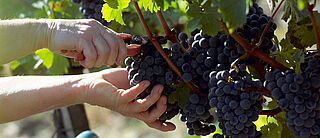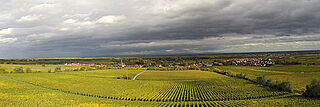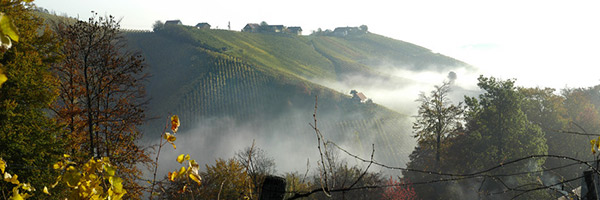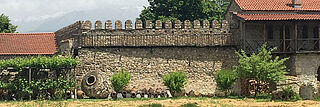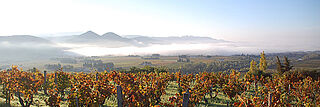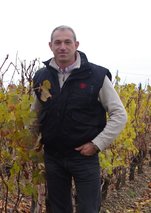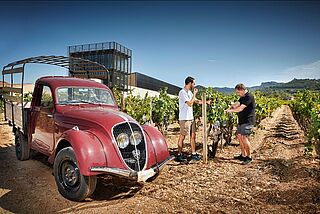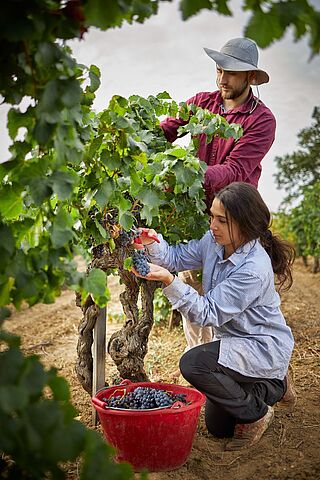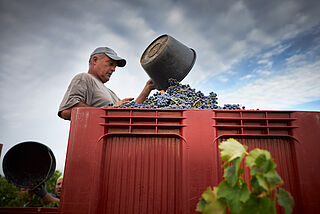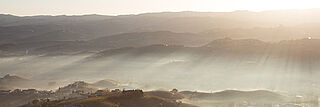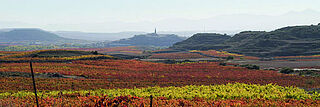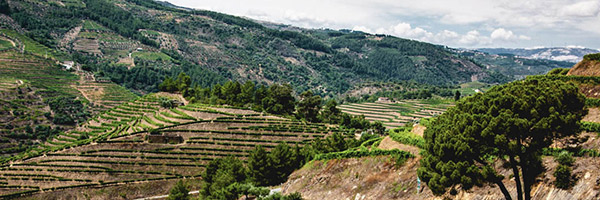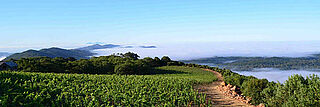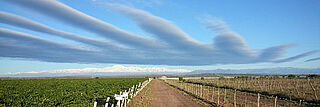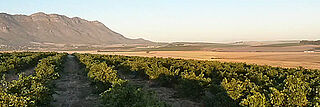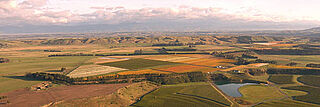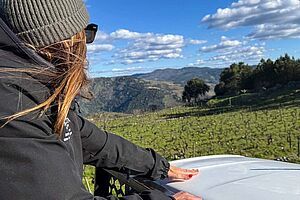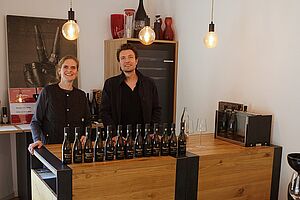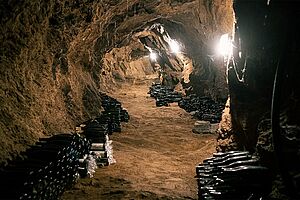Das deutsche Weininstitut vermeldet, dass die eingebrachten Mengen 2019 nochmals geringer ausgefallen sind, als zu Beginn der Weinlese prognostiziert. 19 Prozent unter der Vorjahresmenge im außergewöhnlich ertragsstarken Jahr 2018 und ca. vier Prozent unter dem zehnjährigen Mittel. Natürlich ist das je nach Region verschieden …
Und wie wir alle wissen, Menge ist nicht gleich Qualität. Trockenheit, extreme Hitze im Vegetationsverlauf, oder regional begrenzte Frostperioden und Hagelschläge? Es heißt laut DWI, dass trotz Wetterkapriolen die Qualität des neuen Jahrgangs von Erzeugern in den Anbaugebieten mehrheitlich sehr gut beurteilt wird. Für Österreich liest man ganz ähnlich:
Teilen unsere Winzer diese Auffassung? Wie schätzen sie nach der Ernte den Jahrgang bisher ein? Um Ihnen einen realistischen Ausblick zu geben, wie der Jahrgang 2019 ausgefallen ist, haben wir unsere Weinmacher in den Weinbergen und Kellern gebeten ihre Eindrücke zu vermitteln.
Ahr
Wie immer ist die Ahr so ein bisschen im gelobten Land. ☺
Hagel und Frost hatten wir gar nicht und Sonnenbrand nur in ganz wenigen Fällen. Die Qualität ist sensationell. Es wird ein spannender Jahrgang. Sicherlich bringt er nicht die Menge von 2018, aber das war ja auch schon fast zu schön um wahr zu sein.
Nach dem sehr heißen, trockenen Jahr 2018 haben wir 2019 wieder eine feine Säure und eine schöne Fruchtstruktur. Das heißt wir dürfen uns auf sehr elegante und filigrane Weine freuen, die aber aufgrund der heißen Periode eine Wahnsinns Länge und Struktur haben werden. Sehr spannende Weine. Wir freuen uns drauf.
Baden
Im Großen und Ganzen kann ich die aufgeführte Einschätzung bestätigen. Die Menge bei uns am Kaiserstuhl liegt ziemlich im Durchschnitt der letzten 10 Jahre. Das wir das nicht mit letztem Jahr vergleichen können ist klar.
Der Herbst dieses Jahr war viel mehr von Taktiererei geprägt wie in den Jahren zuvor. Bis zum Beginn der Lese hatten wir wenig Wasser, bis auf einen gewaltigen Niederschlag Mitte August. Die kargen Parzellen, vor allem die GG-Lagen, haben davon viel weniger Wasser ziehen können wie die lössreichen Lagen. Aufgrund dessen waren die GG-Parzellen deutlich früher reif. Der Startschuss fiel Anfang September. Durch kühle Nächte können wir viel Frische bei diesen Weinen Feststellen. Ein Vergleich mit 2013 ist durchaus zulässig.
Im weiteren Verlauf der Lese hat das Wetter sich gedreht und Regen ersetze Sonnenschein. So mussten wir gegen Ende Gas geben um gesunde Trauben zu ernten. Alles in allem ein eher anstrengender Herbst.
2019 war ein bei uns vom Ertrag ca. 10 % unter dem Vorjahr, vor allem die burgundischen Pinot Noir Reben haben deutlich weniger Ertrag gebracht. Ähnlich wie letztes Jahr war hingegen Weißburgunder.
Normalzustand ist beim Wetter zwischenzeitlich das Extrem. Wir hatten einen sehr warmen und trockenen März April, dafür Schneefall am 4. Mai. Mit 0 °C blieb der Schnee nur kurz liegen, so sind wir gerade noch an Frostschäden vorbeigeschrammt. Dafür sind dann Juni und Juli teilweise extrem heiß gewesen. Mit 40 °C sind wir gerade noch größeren Hitzeschäden entgangen
Nach dem wir uns jahrelang gegen die Installation einer Tröpfchen-Bewässerung gesträubt haben, haben wir solche Anlagen in drei Weinbergen aufgebaut. Im nun vierten Trockenjahr in Folge ließ sich das in Weinbergen mit steinigen, flachgründigen Böden nicht mehr vermeiden. Erfreuliche war, mit diesen Tropfschläuchen hatten wir mit relativ wenig Wasser einen guten und bleibenden Erfolg. Es war schön zu sehen, wie sich die Reben schnell und nachhaltig erholt haben. Zwiespältig für mich dennoch: ein weiterer Eingriff in den Naturkreislauf und in den Jahrgangsverlauf, ein hoher zusätzlicher Arbeits-Aufwand.
Die 2019er Weine sind schön. Etwas leichter, frischer und straffer als die Jahrgänge zuvor. Eher hintergründige, subtile Kraft, genauso, wie wir das mit unseren Weinen ausdrücken wollen.
2019 – mal wieder ein »normaler« Herbst
Nach den rekordverdächtig frühen Lesen der vergangenen beiden Jahre stand uns 2019 mal wieder ein »normaler« Herbst ins Haus – sprich ein Herbstbeginn im letzten Septemberdrittel.
Die Temperaturspitzen in den Hitzephasen Juni/Juli mit Temperaturen von über 40 Grad in einigen Weinbergen führten trotz nur geringer Entblätterung der Stöcke stellenweise zu Sonnenbrand. Da auch die Reifeentwicklung nicht so einheitlich verlief wie im letzten Jahr, startete unser »Herbscht« mit einer Vorlese.
Richtig rund ging es dann mit dem Grauburgunder, den wir, abgesehen von den alten Anlagen, als erstes in den Keller geholt haben. Es folgte das »volle Programm« beim Spätburgunder, den wir quasi am Stück aus unseren Weinbergen geerntet haben. Da wir mit über 20 Erntehelfern sehr schnell unterwegs waren, kamen wir auch nicht in Zeitnot wegen eventueller Überreife. Es folgte der Syrah, der sich in unserem Klima inzwischen mehr als wohl zu fühlen scheint: Die Beeren waren traumhaft reif und versprechen tolle Qualitäten.
Pünktlich zum Traumwochenende am 12. und 13. Oktober landeten dann mit Weißburgunder, Chardonnay und Gutedel die letzten Trauben im Keller. Und obwohl uns die Zuckerwerte unserer Trauben nicht als maßgebliches Qualitätskriterium gelten: Eine Parzelle mit alten Gutedelstöcken erreichte 2019 an die 90 Oechsle. Insofern bemerkenswert, weil Gutedel normalerweise zwischen 70 und 80 Oechsle liegt.
Trotz dieses »Ausreißers« verspricht dieser Jahrgang viel: Die meisten unserer weißen und roten Toptrauben lagen um die 95 Oechsle und damit im für unsere Stilistik idealen Bereich. Hinzu kommt eine ausgeprägte Säure bei niedrigen pH-Werten. Diese Kombination verspricht Weine, die trotz guter Struktur und Dichte dennoch saftig sein werden.
Franken
Die Natur kommt nun zur Ruhe. Es regnet, ein kalter Wind dazu – das klassische Herbstwetter.
Regen war im Sommer 2019 auch wieder ein sehr knappes Gut, was uns vor immer größere Herausforderungen stellt. Das größte Problem beim Jahrgang 2019 war allerdings eine Spätfrostnacht, die am 5. Mai lokal nur in Retzstadt unsere Weinberge fast komplett vernichtet hat. Mit einem Ertrag von rund 20 Hektoliter pro Hektar haben wir 2019 die kleinste Ernte in unserer Weingutsgeschichte eingefahren.
Etwas entschädigt hat uns die Qualität des Jahrgangs. Die animierende Säure mit den optimalen Zuckerwerten zeigt schon im jungen Stadium im Keller, dass wir uns auf großartige Weine im Frühjahr freuen dürfen.
Unser Sohn Benedikt hat neben seinem Job als Außenbetriebsleiter im Weingut auch seinen Ausflug in die große weite Weinwelt mit dem Titel zum IKH-Sommelier erfolgreich abgeschlossen. Unsere Jüngste, Sophia, ist im Juni zur Retzstadter Weinprinzessin gekürt worden. Sie ist mit großem Spaß dabei und sammelt viele Eindrücke in ihrem neuen Amt.
Wir freuen uns sehr und fühlen uns geehrt, dass wir im Weinführer Eichelmann in die Kategorie zum »WELTKLASSE Weingut« aufgestiegen sind. Zudem führt unser 2018er HIMMELSPFAD Silvaner GG die Silvaner-Riege in der Bestenliste an.
Auch im Gault-Millau wird der 2018er Silvaner HIMMELSPFAD GG als bester deutscher Silvaner ausgezeichnet.
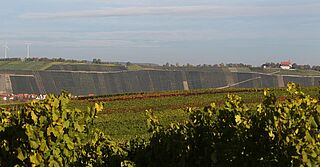
Das neue Jahr startete ähnlich wie das Jahr 2018 zu Ende ging. Das Regendefizit von ca. 130 Liter pro Quadratmeter wurde auch im Januar, Februar und März wegen fehlender Niederschläge nicht aufgefüllt. Auch die Temperaturen waren gegenüber dem langjährigen Mittel durchgehend zu warm. Der April startete mit normalen Temperaturen, die bis Mitte des Monats immer sommerlicher wurden und zu einem schnellen Austrieb führten. Von Ende April bis Mitte Mai waren die Temperaturen durchwachsen, der ersehnte Regen fiel leider nicht. Die Blüte der Reben begann dennoch ca. 14 Tage vor dem langjährigen Mittel und war Mitte Juni bereits abgeschlossen. Wir warteten, und warteten, aber er kam nicht, der Regen …
Wie schon im Jahr zuvor, versorgten wir unsere Reben mit Wasser aus unserem Ortsbrunnen und aus dem Main. Das dies auch dieses Jahr wieder die Richtige Entscheidung war, zeigte sich im weiteren Witterungsverlauf, der uns keinen Regen bis zur Weinlese brachte. Der August war mit warmen, bis sehr heißen Temperaturen, auch viel zu trocken und die zwei heißen Tage Mitte August mit über 40 Grad verbrannten nicht nur frühreife Sorten wie Bacchus, sondern auch Rieslinge und sogar teilweise Rotweinsorten.
Der September startet mit kühlen Temperaturen und sehr kalten Nächten, was für eine großartige Aromabildung in der Traube gesorgt hat. Am 12. September starteten wir mit der Weinlese mit warmen, aber nicht zu heiß Temperaturen und mit weiterhin kühlen Nächten. Dass 22 Tage später, die Lese schon abgeschlossen sein sollte, daran dachte am Anfang noch keiner. Hatten wir die letzten zwei Jahre schon geschrieben, die schnellste Lese in der Geschichte des Weinguts gemacht zu haben, so zeigte uns 2019 das wir noch schneller sein mussten und konnten! Die Frage ob wir zu schnell unterwegs sind, stellten wir uns mehr als einmal, die Presse lief 20 Stunden am Tag und der Kaffee in strömen. Das es gut war auf unser Bauchgefühl zu hören, war bestätigt nachdem genau nach unserem letzten Lesetag am 3. Oktober der Regen kam …
Wir sind sehr zufrieden mit den Mosten, die gerade in unserem Weinkeller gären! Weine mit moderatem Alkohol und einer intensiven Aromatik gepaart mit einer ansprechenden Säure.
Mosel Saar Ruwer
2019 Mosel Vintage – Epic at the Top?
What does 2019 have in store? The growing conditions were pure drama: Late frosts, record heat wave, and rain during the harvest. And yet something truly remarkable seems to have emerged from this roller-coaster of a vintage. Here a sneak preview.
The growing conditions were a roller-coaster ride of extremes.
Spring proved a rather average affair, was it not for a spell of frost in early May. It almost passed unnoticed, even to growers, but had d evastating effects, especially in the central part of the Saar. Flowering was comparatively late (around mid-June) and this was followed by quite some extreme weather in the summer. Heat waves (setting new temperature records through Germany) for days were often followed by spells of rain, putting quite some pressure on the growers.
The harvest proved anything but easy … but the growers did not seem to mind.
Despite a comparatively late flowering, the summer and rain at the beginning of September led to sugar density levels to reac h already 80-85° Oechsle by mid-September. Some growers started their harvest very early in 2019, sometimes as early as mid-September. Those included the growers who had also started early in 2018, but also other growers who »learned the lesson« (as o ne grower put it to us). The bulk of growers started picking around the end of the month, which is still remarkably early, given that flowering was comparatively late. The harvest was marked by quite some rain, which should have added to the high level of stress as rot (noble or not) was spreading. Growers we talk to during the harvest are often unhappy, because they are perfectionists and see all the details that are not ideal (rain at the wrong moment, a harvest worker getting sick, etc.). But that was not the case in 2019, as they were brushing the setbacks from the weather aside. So far, there are no signs of any Eiswein being possible ... not that many growers took the risk back in October and gamble some of their meagre yields on an elusive Eiswein.
And the reason why they did not mind is clear: At the top, 2019 will be epic, possibly an even finer version of 2001.
We soon got wind of the reaso n why growers did not seem to mind the bad weather during harvest: »This could be quite a vintag e« was a regular comment prudently made during harvest. So we were eager to put our nose into some casks at some of the finest growers and we can confirm the hunch of the growers: The wines have incredible precision, play, zest, and structure. At their best, they remind us of 2001, but subtler and deeper. Some of the cask samples of fruity styled Riesling were among the finest young Riesling we have ever tasted. However, 2019 is also a ripe vintage, and not all wines will have the cut. But the potential is simply huge. The vintage has only one serious drawback: Its low yields. There will not be much wine to play with, courtesy of the frost, the scorching hot summer, and the need to discard lesser rain-affected grapes during harvest. The battle for the finest wines is likely to be as fierce as ever.
Eindrücke von der Ernte des Jahrgangs 2019 an Mosel-Saar-Ruwer
Das Vegetationsjahr 2019 war in der Moselregion von einigen Wetterextremen geprägt. Nachdem der Austrieb in der zweiten Aprilwoche unbeeinträchtigt war, verursachten Frostnächte am ersten Maiwochenende an Saar, Ruwer und einigen Seitentälern der Mosel teilweise beträchtliche Schäden. Die Rekordhitze im Monat Juli mit Temperaturen von über 40° Celsius machte dem Riesling zu schaffen, sodass hier eine weitere Ertragseinbuße hingenommen werden musste.
Gut beraten war, der die Traubenlese rechtzeitig beginnen und damit das stabile Erntewetter Ende September / Anfang Oktober nutzen konnte.
In der dritten Oktoberwoche sind die letzten, großen Betriebe mit der Lese fertig geworden.
Insgesamt kann für das Anbaugebiet Mosel-Saar-Ruwer festgestellt werden, dass die Liebhaber, Kenner und Sammler sich auf aromatische, reintönige, rassige Rieslingweine freuen können, die viel Zukunftsperspektive versprechen.
(aus dem Bericht des VDP Mosel-Saar-Ruwer)
Oliver Haag vom Weingut Fritz Haag spricht von einem »kleinen, aber feinen Jahrgang«. Die geernteten Moste lagen ausschließlich im Prädikatsbereich. Alle möglichen Prädikate konnten gelesen werden. Er hob die gute Traubengesundheit und die fein schmeckende Säure des Jahrgangs hervor.
(aus dem Bericht des VDP Mosel-Saar-Ruwer)
Wenn wir den im offiziellen Kataster – Fläche als Birdview – zugrunde legen, haben wir 2019 pro Hektar knapp 40 Hektoliter geerntet. Wenn wir den guten Pythagoras bemühen kommen wir bei einer Hangneigung von durchschnittlich 100 % (45 Grad) auf ca. 27 Hektoliter pro Hektar. Das wäre bei einem durchschnittlichen Flaschenpreis von 50 Euro kein Problem. Aber …
… dafür ist alles andere toll! Kleinbeerige, gesunde Bilderbuchtrauben, verführerisch und hochkonzentriert. Schon im Moststadium jedes Terroir klar und präzise auf der Zunge! Und Botrytis: Seit langem mal wieder viel und gut! Abends und an den Regentagen wurde mit 40 Personen sortiert und sortiert und sortiert … Rekordverdächtige Goldkapsel-, Beeren- und Trockenbeerenauslesen. Wir sind begeistert!
Die Jury von VINUM – ehemals Gault-Millau – hat den 2018er Schieferterrassen in der Kategorie »Gutswein« als Besten des Jahrgangs ausgezeichnet. Und unter den Top 10 deutschen »Grands Crus« sind mit Uhlen Blaufüßer Lay und Uhlen Laubach gleich zwei unserer Weine vertreten. Das freut uns sehr und macht uns stolz: Auf unsere Arbeit, auf unsere fantastischen Terrassen und auf unsere Kunden, die Wein als Kulturgut schätzen, und die nicht auf die vielen Sonderangebote der bunten Werbebeilagen hereinfallen.
AYL (Saar), 100 % Riesling …
– Menge = ca. 45 % weniger als 2018 und ca. 20 % weniger als der Durchschnitt von 2012–2017.
Gründe: Vom natürlichen Ertragspotential des Austriebs im Frühjahr 2019 her gerechnet ca. 5 % Verlust durch Spätfrost an den Hangfüßen – ca. 25 % Verlust durch Sonnenbrand Ende Juli – ca. 15 % Verlust durch frühe Botrytis, die radikal aussortiert und auf den Boden geschnitten wurde. Ansonsten hätten wir ein Ertrag wie im Jahrgang 2018 gehabt.
– Qualität = von Kabinettqualität (ca. 80°Oe) über Spätlesequalität (ca. 85°Oe) aufwärts bis zur guten Auslese (ca. 105°Oe). Moste geschmacklich sehr gut und sauber. Wenn dann Überreife, aber keine Fäulnisnoten.
– Weinstil = durchschnittlich 1 g/l Säure mehr als in 2018, vergleichbar mit 2017. Feine, fruchtige Noten, teils exotisch. In der breiten Masse der Fässer sehr ansprechende Kombination aus mineralischen und zartfruchtigen Noten. Etwas weniger Alkohol als in 2018, vergleichbar mit 2017.
– Portfolio = breites Sortiment an animierenden Kabinetten, und Feinherben Grand Crus, mittlere Menge an trockenen GGs. mittlere Menge an trockenen und feinherben Ortsweinen, kleines Programm edelsüßer Rieslinge
– Empfehlung = 2018er im trockenen und edelsüßen Bereich sichern – trocken bis feinherb, feinherb und feinfruchtig aus 2019 reservieren.
Der Jahrgang 2019 wird wieder als ein Jahr der extreme an der Mosel in die Geschichte eingehen.
Nach einem recht frühen Austrieb und einer normalen Vegetation im Frühjahr haben sich die Winzer wieder auf ein »normales Jahr« im langjährigen Mittel gefreut. Die Spätfröste Anfang Mai haben in einigen warmen Lagen, welche bereits weiter in der Rebentwicklung waren, zu teils größeren Ausfällen geführt. Die Schäden haben sich jedoch nur über einzelne Weinberge erstreckt und waren längst nicht so drastisch wie in 2017.
Auf einen kühlen Mai, der die Rebentwicklung ein wenig verlangsamte, folgte ein 28 % wärmerer Juni (im Vergleich zum vieljährigen Mittel seit 1961). Die Rebblüte fand unter sehr heißen Temperaturen statt, sodass viele Beeren nicht befruchtet wurden. Sehr lockere Traubenansätze haben das Winzerherz höher schlagen lassen. Die heißen Sommertage mit dem deutschen Hitzerekord gemessen an der Mosel, in Trier am 25. Juli mit 40,6° Celsius, haben den Reben zu schaffen gemacht. Ganze Traubenstiele konnten der Hitze nicht stand halten und sind wortwörtlich in der Sonne verbrannt. Diese Trauben sind gänzlich eingetrocknet und haben somit zu einer recht frühen, natürlichen Ertragsreduzierung geführt, die Basis für einen großen Jahrgang.
Ein kühler September mit warmen Tagen und kalten Nächten hat den Trauben eine unheimliche aromatische Reife gegeben. So konnten wir unsere Lese am 30. September beginnen und bereits am 12. Oktober beenden. Das Zeitfenster zwischen perfekter aromatischer Reife und Überreife war aufgrund der Niederschläge in der Lese sehr klein gesetzt. Die Trauben zeigten sich unheimlich aromatisch und intensiv. Der tollen Traubenqualität steht leider wieder mal ein Wehrmutstropfen bei der Menge gegenüber. Mit etwas weniger als der Hälfte des 2018er Ertrags geht die diesjährige Ernte als einer der kleinsten Ernten in die Bücher unseres Weinguts ein.
Das Ergebnis sind hocharomatische Moste mit viel Struktur und einer tollen animierenden, reifen Säure. Die ersten Tage der Gärung verlaufen sehr gut und der Duft im Keller lässt uns sehr optimistisch für das kommende Jahr stimmen.
Der Winter 2018–2019 war mild. Im Dezember gab es sehr viel Niederschlag aber ansonsten war es eher trocken. Januar, Februar und März waren sonnig und recht warm, nur der Mai war kühl und regnerisch. Nach Schneeregen am 4. Mai gab es am 5. und 6. Jeweils leichten Frost, am ersten Tag klassisch mit Schäden unten am Berg, am zweiten Tag wurde die kalte Luft von starkem Nordwind über die Berge getrieben. Es gab Schäden oben im Rosenberg, oben im Braunfels und selbst in der braunen Kupp entlang der Grätebach. Die Entwicklung der Weinberge verzögerte sich und erst Ende Mai blühten die ersten Reben. Ein paar sehr warme Tage Anfang Juni beschleunigten das Wachstum und am 20. Juni war die Blüte beendet.
Es blieb heiß, vom 23.–26. Juli wurden Hitzerekorde aufgestellt. Es gab erhebliche Sonnenbrandschäden in den ganz alten Weinbergen und dort, wo kurz zuvor gegipfelt worden war. Dort wo die Triebe noch nicht beschnitten waren, gab es so gut wie keine Schäden. August und September blieben warm und trocken, erst am 20. September drehte das Wetter. Es wurde warm und naß und Botrytis begann, sich auszubreiten.
Die Reife der Trauben schritt gut voran und wir bereiteten uns wieder auf eine Traubenlese im September vor. Erstaunlicherweise stiegen die Mostgewichte im September erst einmal nur sehr langsam und die Entscheidung über den Leserbeginn war nicht einfach. Nach einer eher regnerischen Woche begannen wir am 30. September bei schönem Wetter mit der Ernte.
Von Anfang an konnten wir edelfaule Trauben selektieren und Zucker und Säure schienen in perfektem Verhältnis. Vom 6. Bis zum 8. Oktober war es regnerisch und wir mussten öfters pausieren. Dann aber wurde es wieder schön und wir ernteten in Saarburg und im Braunfels Trauben für den »Scharzhof«.
Ab dem 12. stiegen die Mostgewichte mit zunehmender Botrytis rasant und wir konnten wieder edelfaule Beeren auslesen. Längerfristig waren die Wetteraussichten jedoch nicht gut und wir hielten das Tempo hoch, da wir bei weiterem Regen um die Qualität der Trauben fürchteten. Am 18. Oktober war die Ernte zuende.
Seit 2014 waren die Sommer heiß und es war tendenziell zu trocken. Die alten Reben scheinen unter diesen Umständen weniger wiederstandsfähig zu sein und so konnte die Reblaus sich erheblich ausbreiten. In einem unserer alten Weinberge hatten wir schon seit Jahren Reblausbefall festgestellt. Im heißen Sommer 2018 waren viele Stöcke abgestorben und 2019 verschlimmerte sich die Situation so, daß Ertrag und Qualität massiv betroffen waren und wir beschlossen schweren Herzens, diese Parzelle auszuhauen.
Die Ernte 2019 ist insgesamt klein, aber von hoher Qualität. Im Durchschnitt haben wir 20 Hektoliter pro Hektar geerntet, bei allerdings erheblichen Unterschieden von Weinberg zu Weinberg. Während es in der braunen Kupp fast zufriedenstellende 25 Hektoliter pro Hektar waren, kamen wir im Scharzhofberg aufgrund von Frost, Sonnenbrand und Reblaus nur auf 18 Hektoliter pro Hektar. Im Unterschied zu 2018 ist 2019 ein klassischer Bοtrytisjahrgang. Gemessen an der insgesamt kleinen Erntemenge gibt es reichlich Spät- und Auslesen aber sehr wenig Kabinett. Erste Proben lassen einen Vergleich mit dem 99er zu.
Man redet ja immer gerne über das Wetter, meist einfach, weil einem nichts Besseres einfällt, immer im Hinterkopf, dass man es eh nicht ändern kann. 2019 war das Wetter aber durchaus mehr als Smalltalk.
Wir starteten relativ normal in den Jahrgang 2019, Austrieb und Blüte der Reben verliefen gut. Der Sommer brachte uns Rekordhitze und lange Trockenperioden. Tiefes Wurzelwerk und Adaption an unsere extremen Steil- und Terrassenlagen ließen unsere Reben auch dies meistern. Wir schauten einem mengenmäßig kleinen und qualitativ hochwertigen Jahrgang entgegen. Der Regen, der uns im Sommer nicht gegönnt war, kam dann im Herbst. Und dann leider zu viel davon.
Da wir ausschließlich trockene Weine ausbauen und somit nur 100 % gesundes Lesegut verwerten können, war die Weinlese eine Sisyphosarbeit und ein Marathon. Selektion der Trauben und immer wiederkehrende Lesepausen auf Grund von Regen trugen dazu bei, dass unsere Weinlese 2019 an einigen Tagen endlos erschien. Leider können wir an der Mosel nicht von durchschnittlichen Erträgen sprechen.
Am Ende wird alles gut … 2019 kann bei uns recht einfach beschrieben werden: Qualität hat ihren Preis! Geringer Ertrag auf Grund der starken Selektion, deshalb aber auch Top-Moste, die zu Top-Weinen werden.
An der Ruwer haben Frost im Mai und Hitze im Juli die Erntemenge fast halbiert. Wie im ganzen Anbaugebiet Mosel kann registriert werden, dass das »Erntefenster«, d. h. die verfügbare Zeit für die Lese des Rieslings von der physiologischen Reife bis zum optimalen Ende immer kürzer wird. Das stellt die Ernteteams immer wieder vor große Herausforderungen.
Im Weingut Maximin Grünhaus wurde die Lese in der letzten Septemberwoche mit Pinot Blanc und Pinot Noir begonnen. Seit 10 Jahren lässt sich feststellen, dass besonders der Pinot Noir mit den teilweise extremen Wetterlagen gut zurecht kommt. In fast allen Jahrgängen sind hochgrädige Moste mit guter Farbintensität, feiner Säure und viel Aromatik geerntet worden.
Die kleine Riesling-Ernte wurde mit einem idealem Mostgewicht / Säureverhältnis (1:10) eingebracht: Es können reife, rassige, tiefgründige und langlebige Rieslingweine erwartet werden!
(aus dem Bericht des VDP Mosel-Saar-Ruwer)
Wir sind sehr zufrieden mit der Ernte. Mit 44 Hektoliter pro Hektar sind wir auch noch mit einem blauen Auge davon gekommen was die Menge betrifft.
Die Qualitäten sind gut bis ausgezeichnet, nur das Wetter während der Ernte war sehr bescheiden. Es werden typische frische leichte aber aromastarke Saar-Riesling-Weine wie man sie kennt, vergleichbar vielleicht mit 2016.
Roman Niewodniczanski vom Weingut Van Volxem freut sich über hervorragende Moste für reichhaltige, trockene Weine. Die Grundlagen für exzellente GROSSE GEWÄCHSE sind auch in diesem Jahrgang gelegt!
Allerdings: »Der Herbst mit großem handwerklichem Aufwand für die Gewinnung optimalen Leseguts war teuer!«
(aus dem Bericht des VDP Mosel-Saar-Ruwer)
Nahe
Der Jahrgang 2019 brachte an der oberen Nahe exzellente Qualitäten bei sehr niedrigen Erträgen. Durch einen geringen Gescheinsansatz (= wenig Trauben), starke Verrieselung während und nach der Blüte (= wenig Beeren pro Traube) und optimale Laubarbeit war die Traubenzone sehr gut durchlüftet und die Trauben blieben lange gesund. Mostgewicht und Säure lagen durchweg im idealen Bereich.
Die Lese begann bei uns am 23. September und endete am 19. Oktober. Trotz der häufigen Regenschauer in dieser Zeit gelang es die Regenlücken gut zu nutzen und die Trauben trocken zu ernten. Vereinzelt auftretende Botrytis wurde zur Erzeugung von Auslesen und Beerenauslesen genutzt.
Die Trockenheit im Sommer hatte im Übrigen auf die Höhe des Ertrages wenig Einfluss, für die Gesundheit der Reben war sie vorteilhaft.
Pfalz
Die Erntemenge liegt bei uns noch geringer als im Bundesdurchschnitt, 15 % unter dem langjährigen Schnitt 30 % unter dem Jahr 2018.
Aber straffe Weine mit fantastischer Säure, ganz auf der kühlen Seite. Wir hatten vollreife Kerngesunde Trauben und wurden vor dem Regen ganz fertig. Sind also super zufrieden. Man wird sehen wie es wird, aber gut aussehen tut es alle mal.
Der Jahrgang 2019 war sehr heterogen und anspruchsvoll. Später Austrieb und Blüte, dann große Hitze und Trockenheit im Sommer. In einigen Teilen auch »Trockenschäden« die penibel rausselektiert wurden. Einige Weinberge haben relativ früh hohe Reifewerte erreicht, andere jedoch ungewöhnlich spät. Dies musste man einschätzen können und auch dann Geduld haben, trotz kommender Regentage.
Am 3. September haben wir mit der Ernte begonnen. Die Säurewerte und der Geschmack der Trauben waren top und so konnten wir auch schon früh unsere GG Spätburgunder und Weißburgunder ernten. Diese Lese verlief optimal, alles war hier kerngesund wenngleich die Menge extrem gering ausfiel Spätburgunder im Durchschnitt bei 32 Hektoliter je Hektar (inkl. Guts- und Ortswein).
Die Rieslinglese war differenzierter. Hier starteten wir am 18.9 in Ungstein, das erste GG kam am 23. September aus dem Weilberg in den Keller mit 97 Öchsle und 9,5 Säure! Kallstadt musste noch deutlich warten. Hier begannen wir am erst am 4. Oktober und beendeten die Lese mit unseren Rieslingen aus dem Saumagen am 9. Oktober ebenfalls mit Werten zwischen 90–96 Öchsle und Säurewerten zwischen 8 und 9 Gramm. Die Werte waren optimal und der Geschmack der Trauben auch, allerdings war viel Arbeit dafür notwendig. Denn durch die zwischenzeitlichen Regentage mussten wir viele Beeren aussortieren.
Die Moste oder Jungweine probieren sich sehr vielversprechend nur gibt es dieses Jahr extrem wenig davon. Im Durchschnitt haben wir über das ganze Weingut hinweg einen Ertrag von 47 Hektoliter je Hektar.
Rheingau
Wir haben für unser Bischöfliches Weingut Rüdesheim eine super Qualität eingefahren. Durch die Wetterkapriolen haben wir allerdings nicht die Menge aus dem zehnjährigen Mittel gelesen – im Besonderen in den Rüdesheimer Lagen. Hier sind es nur ca. 40 % der Vergleichsmenge zum Vorjahr gewesen (unter 40 hl/ha) – durch Handlese allerding top selektioniert.
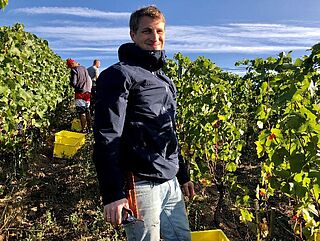
Das Gefühl, wenn man am Ende einer Weinlese steht, und nach vier Wochen im Dauerlauf gerade die letzten Trauben gelesen hat, ist nur schwer in Worte zu fassen. Es war eine Lese, die zunächst ganz unscheinbar, verlockend und spielerisch zu werden schien, die dann aber mit jedem Tag ein Stückchen mehr von ihrem wahren Charakter offenbarte und zur echten Herausforderung wurde.
Bei malerisch spätsommerlicher Wetterlage begann unsere Lese ganz in Ruhe am 13. September. Doch Anfang Oktober mussten wir während unserer Ernte – ironischer Weise durch das Tiefdruckgebiet »Peter« – einigen Regen einstecken. So erlebten wir eine Lese, die auf Grund ihres Witterungsverlaufs in Sachen Sorgfalt und Selektionsintensität höchste Ansprüche an uns stellte. Eine Lese, in der die Achtsamkeit nie absacken durfte und die Konzentration konstant hochgehalten werden musste. Eine Lese, die Ausdauer und Widerstandskraft permanent gefordert hat, denn es gab keinen Raum für Nachlässigkeiten oder Verschnaufpausen. In vielen Herbstberichten geht es gerne um die romantische Magie, die während der Weinlese entsteht. Doch dieses Jahr war wenig Platz für Herbstromantik. Der wahre Kern der Schönheit und die echte Romantik des Jahrgangs 2019 liegt für uns darin, dass die Herausforderung so schwierig, dass der Aufwand so enorm war. Die Schönheit war verschlossen und musste erst mit großem Einsatz und viel Sorgfalt erkämpft werden.
Nur die romantischen Szenen der Lese zu zeichnen, wäre den Menschen nicht gerecht geworden, die diese Qualität und Klarheit, die diesen Sieg mit uns gemeinsam erkämpft haben. Ein Sieg, der uns stolz macht – ein Spiel, das uns alles abverlangt hat, und auf das wir jetzt mit großem Spaß zurückblicken können, denn wir haben wieder alles gegeben.
So ist 2019 ein brillanter Jahrgang geworden. Kristallin und tiefgründig, voller Spannkraft und lebendiger Vibration. Wir freuen uns schon jetzt sehr darauf, die Weine bald mit Ihnen zu probieren.
So ist 2019 ein brillanter Jahrgang geworden. Kristallin und tiefgründig, voller Spannkraft und lebendiger Vibration.
– Peter Bernhard Kühn
Der Jahrgang 2019 hat ja viel positives im Vorfeld versprochen und die Vegetationsperiode ist, abgesehen von einer nicht ganz so guten Wasserversorgung sehr zufriedenstellend verlaufen.
Wir haben jedoch einige Anlagen, die in Folge der Trockenheit etwas gelitten haben. In unseren Premium-Lagen hat das jedoch keinen Ausschlag gegeben und durch ein intensives Ausdünnen und Arbeiten an der Laubwand sind die Erträge hier mehr als zufriedenstellend.
Während der Ernte hat die Witterung etwas Kapriolen geschlagen und wir mussten recht zügig unsere Trauben nach Hause bringen. Was wir im Keller am Gären haben ist sehr vielversprechend und lässt einen sehr guten Jahrgang erwarten …
Rheinhessen
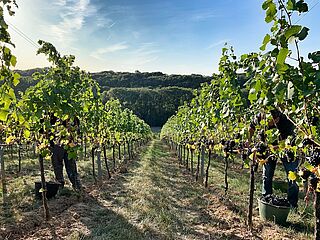
Die neuen Weine liegen nun seit einigen Wochen in unserem Keller. Zeit für einen kleinen Rückblick und ein erstes Resümee.
Das Frühjahr begann durchwachsen. Auf einem warmen und trockenen März/April folgte ein sehr regenreicher und kühler Mai. Der Entwicklungsstand der Reben lag bis dato auf gewohntem Niveau und wir erwarteten die Rebblüte im nördlichen Rheinhessen nicht vor Mitte Juni. Im Juni und Juli erlebten wir zwei große Hitzewellen. Die heißen Temperaturen und der geringe Niederschlag über Wochen bremste das Wachstum der Weinberge ab, wodurch sich auch der Traubenertrag auf natürliche Weise deutlich reduzierte.
Die Lese begann am 21. September mit kleinbeerigen Spätburgundertrauben wie aus dem Bilderbuch. Die generell geringen Erträge ließen trotz der sehr wechselhaften und kühlen Herbstwitterung die Reife stetig voran schreiten. Wie im letzten Jahr galt es vor allem bei den Burgundern und Chardonnay, aber auch in den wärmeren Riesling Lagen die Trauben nicht zu spät oder gar überreif zu ernten.
Der Riesling zeigte sich am deutlichsten geprägt von dem intensiven Sommer. Keine Traube größer als dass sie nicht in eine Handfläche passte, lagen die Erträge mit nur 20 bis 50 Hektoliter pro Hektar rekordverdächtig niedrig. Ein sonniges Hoch in der zweiten Oktoberwoche brachte dann auch in den kühleren Lagen den letzten Reifekick und am 16. Oktober, nach nur 3½ Wochen war der Jahrgang mit den Trauben aus dem Hundertgulden vollends eingebracht.
Die Moste schmeckten etwas weniger üppig und zart wie im Vorjahr, zeigten dafür aber umso mehr Frucht und Frische. Nach eher kurzen Maischestandzeiten und Mostvorklärung gären die Moste derweil hervorragend. Die ersten schon trockenen Partien probieren sich sehr fein und reduktiv. Sie bekommen nun die nötige Reifezeit auf ihrer Hefe. Wir erwarten mit dem 2019er einen spannenden und charaktervollen Jahrgang mit Finesse und Alterungspotenzial.
Der Jahrgang 2019 war die 129. Weinlese unsere Familiengeschichte. Wie haben gelernt, dass es in der Natur und dem Weinbau immer um Balance geht. Wir arbeiten für den Weinberg, nicht er für uns. Er bestimmt den Rhythmus, wir wirken nur begleitend. Daher waren wir nach den zwei trocknen Jahren und dem hohen Ertrag in 2018 nicht überrascht, dass die Menge in 2019 ca. 1/3 unter dem Durchschnitt lag. Die Qualität der gelesen Trauben, hat uns aber wieder mehr als versöhnt.
Die Wintermonate von Januar bis April waren schon eher mild, im Durchschnitt der Jahre ca. 2 °C zu warm. Auch die Niederschläge fielen eher spärlich aus. Als dann der Austrieb Mitte April startete, ähnlich wie 2018, war eine Wiederholung des Extremjahrgangs zu erwarten!
Im Mai gab es allerdings einen Kälteeinbruch, ohne Frostschäden, der zu einer nur sehr zögerlichen Rebenentwicklung führte. Deshalb hatten wir auch eine verzögerte Blüte. Am 8. Juni 2019 war Blütestart in unserer TOP-Lage Binger Scharlachberg und damit ca. eine Woche hinter dem Vorjahr. Allerdings zwei Wochen vor der Norm!
Im Juni und Juli gab es Hitzerekorde mit jeweils einer Woche über 40 °C. Dadurch gab es dann auch Sonnenbrandschäden Ende Juli, die bei uns sehr moderat ausfielen, da wir bei diesen heißen Temperaturen keine Entblätterung der Traubenzone durchgeführt hatten!
Der große Regen kam dann im August mit einem Plus von 46 %. Das schien sich dann Anfang September zu entspannen, bis ab ca. Mitte September ein gefühlter Dauerregen bis Mitte Oktober startete! Insgesamt ca. 150 Liter pro Quadratmeter!!!
Bei warmen Temperaturen blieb das natürlich nicht ohne Folgen. Wunderbare, kerngesunde Trauben platzten auf, wie man das von den Tomaten kennt. Zuerst die Hitze, dann der viele Regen machten den Beerenhäuten doch sehr zu schaffen. Ausgezahlt hat sich dieses Jahr wieder mal das Wickeln der Triebe in den »Großen Lagen« Scharlachberg, Kirchberg und Osterberg. Diese Trauben waren extrem locker und den Beeren schien das Wetter nichts anhaben zu können. Unser Handlese-Team wurde vor eine nicht ganz leichte Aufgabe gestellt: selektieren, selektieren, selektieren!!!
Was letztendlich im Keller landete war jedoch mehr als genial. Die perfekt selektierten Trauben ergaben wirklich herausragende Weine. So konnten wir drei trockene Lagenrieslinge ernten, deren Triebe alle gewickelt wurden und somit lockere, gesunde Trauben erbrachten. Ebenso im süßen Bereich von Kabinett bis Beerenauslese alles mit dabei. Und die ersten durchgegorenen Weine sind extrem vielversprechend!!! Doch zum lachenden Auge gehört leider auch das Weinende: Gegenüber 2018 hatten wir 28 % weniger Mengenertrag. Und gegenüber dem Durchschnitt ca. 12 %
Alles in allem wiedermal ein Jahrgang, der sehr viel Engagement und Zeit gekostet hat, aber weinqualitativ sicherlich weit oben einzuordnen ist! Wir sind also sehr optimistisch für einen genialen Jahrgang 2019. Denn selbst im Extremjahr 2018 ist es uns gelungen, insbesondere aus den Toplagen, eine hervorragende Jahrgangs-Kollektion zu keltern.
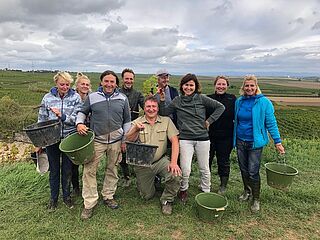
Der Jahrgang 2019 liegt mir besonders am Herzen. Es ist bereits der 10. Jahrgang in der noch jungen Geschichte des Weinguts und der erste, den wir in komplett ökologischer Wirtschaftsweise bearbeitet haben. Biologisch zu arbeiten war schon lange mein Wunsch und wir sind froh, dass wir das erste Jahr trotze mancher extremer Wetterlagen gut gemeistert haben.
Die Natur spielte, wie so oft in den letzten Jahren, verrückt. Das stimmt nachdenklich und stellt uns Winzer immer wieder vor große Herausforderungen. Die Rekordhitze im Juli mit bis zu 40 Grad ist keinem in Europa entgangen und auch in diesem Jahr, mussten sich die Rebwurzeln tief nach Wasser strecken. Waren 2018 die Wasserreserven nach dem Winter noch gut gefüllt, starteten wir 2019 bereits mit einem Defizit in die Vegetationsperiode. Die Rebstöcke mussten sich nach der Verausgabung im letzten Jahr und der langen Trockenheit schonen, daher haben sich die Trauben sehr locker und klein entwickelt sodass wir unterm Strich den kleinsten Jahrgang in unserer Weingutsgeschichte eingefahren haben.
Als dann im August endlich der Regen kam, atmeten wir auf und die Trauben konnten 6 Wochen vor Erntebeginn das lang ersehnte Wasser tanken. Die Menge ist zwar ein Wermutstropfen, aber der Geschmack und die Qualität versöhnen uns sehr.
Die Weine aus 2019 werden fein und elegant mit Druck und tollem Extrakt. Könnte sich zu einem meiner Lieblingsjahrgänge entwickeln.
Unsere seit 2018 BIO-zertifizierten Weingärten starteten bestens gepflegt in die Vegetationsphase 2019. Nach einem warmen und mäßig feuchten Winter, begann das Frühjahr trocken und fast sommerlich. Der zeitige Austrieb ließ Spätfröste befürchten. Im Mai wurde es dann auch sehr kühl. Die Temperaturen blieben jedoch fast immer über der Gefahrenschwelle, und so kamen wir mit minimalen Einbußen davon. Als Segen erwies sich die mit der Kühle einhergehende Feuchtigkeit, sie sorgte auch dafür, dass die Stöcke gut versorgt in die Blühphase gelangten. Diese war Mitte Juni bereits abgeschlossen, relativ früh, aber doch um fast zwei Wochen später als im Jahr 2018.
Ab dem Beginn der Lese für den Verjus und die Sektgrundweine Ende August entwickelten sich die Bedingungen geradezu ideal, um alle Sorten, Weintypen und Lagen ohne Hast und mit der nötigen Sorgfalt gesund und in perfekter Reife einzubringen. Die Lese wurde in der Folge nur von einigen kurzen Regenphasen unterbrochen, begleitet von kühlen Temperaturen und viel Wind. Ein Glück, denn der beständige Wind trocknete die Reben schnell ab, es entwickelte sich kaum Botrytis aber sehr wohl bereits in den frischen, klassischen Weinen eine zarte aber tiefgründige Aromatik, die so typisch für die besten Weine des Kamptals ist.
Als am 21. Oktober im Weingut Bründlmayer die Lese abgeschlossen war, blickten wir nur in zufriedene, entspannte Gesichter. Die Menge liegt leicht unter dem langjährigen Durchschnitt, aber der Jahrgang, da sind wir zuversichtlich, hat das Potential, groß zu werden.
2019 zeigt sich im Keller schon vielversprechend, nachdem fast alle Weine ihre alkoholische Gärung problemlos durchlaufen haben. Duftiger Zweigelt Rosé wird, wie’s aussieht, bereits zu den Festtagen viel Genuss bereiten!
Bei uns war die Ernte Anfang Oktober zu Ende. Es war eine sehr angenehme Lese, weil kein Regen uns gestört hat und die Temperaturen bei max 25 Grad lagen. Kühle Nächte bis zu drei Grad waren für die Aromatik natürlich auch wichtig.
Wir hatten im Juni/Juli eine Trockenphase von fast sieben Wochen ohne Regen. Daher führten wir eine Ausdünnung bei unserer Junganlage durch. Die älteren Reben haben diese Trockenphase gut überstanden. Vor der Lese hatten wir dann noch einige Regentage. Einmal sogar mit leichtem Hagel, was bei betroffenen Lagen zu einem geringen Ernteausfall von ca. 5–10 Prozent führte. Die Erntemenge war im alljährigen Durchschnitt, aber natürlich geringer als die letzten beiden Jahrgänge.
Die Qualität des Traubengutes war hervorragend. Wir hatten die üblichen Krankheiten im Weinbau heuer sehr gut unter Kontrolle. Kein Mehltau und keine Botrtis war während der Lese auf den Trauben zu finden.
Da die Traubenqualität einwandfrei war, bin ich auch sehr zuversichtlich auf die Qualität im Wein. Es gären noch viele Weine, daher ist es noch schwer abzuschätzen, wie die Weine schlussendlich schmecken werden. Potenzial ist auf jeden Fall viel vorhanden.
Wenn man sich als Winzer etwas wünschen darf, dann ein 9er Jahr!! Aus welchem Grund auch immer, die 9er Jahre gehören immer zu den Besten.
Nach einem sehr trockenen und wieder einmal zu milden Winter wurden die Sorgen beim Austrieb, durch einen kühlen (aus heutiger Sicht!) und niederschlagsreichen Mai aufgelöst. Die Blüte fiel daher auch in eine »normale« Zeit Mitte Juni und verlief gut aber nicht zu gut und somit war der Fruchtansatz deutlich unter dem Rekordjahr 2018.
Der Sommer blieb zwar wieder einmal trocken und teilweise auch heiß, doch in Summe gab es immer rechtzeitig Regen und kühle Phasen. Das gesamte Jahr war ungefähr zwei Wochen später als 2018, d. h. noch immer etwas früher als man das von den 80er Jahren kannte. Wahrscheinlich war es ein Jahr des »neuen Normal!«
Die Weinlese begann für Sekt in der letzten Augustwoche und endete für die Herkunftsweine des Kamptals am Ende der ersten Oktoberwoche. Wenige Tage waren verregnet. Physiologische Reife, Geschmack der Trauben und Analyse des Saftes geben uns Hoffnung dass der Weinjahrgang 2019 zu den ganz ganz Guten gehören wird. Wie weit oben in der Bestenliste wird man aber erst in einiger Zeit wissen! Die Menge ist natürlich deutlich hinter 2018 geblieben dürfte sich aber nur etwas unter dem langjährigen Durchschnitt befinden.
In Österreich schaut die Situation ganz ähnlich wie in Deutschland aus.
Gott sei Dank sind wir von Frost und Hagel verschont geblieben, abermals hat uns aber die Trockenheit zugesetzt, v. a. in den südlich exponierten steilen Hängen und Terrassen des Kremstals sowie in der pannonischen Tiefebene des Neusiedlersee-Gebietes.
Fazit: Die Ernte ist in etwa 30 % geringer ausgefallen als die (ziemlich ausgiebige) 2018er. Das Traubenmaterial war durchwegs gesund. Die Qualitäten zeigen sich jetzt, da die meisten Weine durchgegoren sind, recht vielversprechend. Durch frühzeitige Lese sind die Alkoholwerte im Rahmen, die Säurestruktur balanciert.
Alles in Allem ein Jahrgang, der sich in die Reihe der renommierten 9er-Jahrgänge einreihen könnte.
Zu allen Weinen
Der Jahrgang 2019: vollreife und sehr gesunde Trauben lassen fruchtbetonten, nervig-eleganten Jahrgang erwarten! Der 2019er wird sich in die hervorragenden 9er-Jahrgänge der letzten Jahrzehnte in vortrefflicher Weise einordnen. Alle Voraussetzungen für einen ausgezeichneten Jahrgang sind gegeben!
Die Ernte begann heuer wieder – wie vor den Hitzejahren üblich – Anfang Oktober. Besonders erfreulich war das gute Lesewetter während der gesamten fünfwöchigen Ernteperiode. Das warme Jahr mit einigen Trockenphasen brachte eine sehr gute Traubenreife sowohl bei Grünem Veltliner als auch bei Riesling. Die Mengen allerdings sind durchwachsen: durchschnittlich bei Grünem Veltliner, ein Drittel weniger beim Riesling. Bemerkenswert ist die geringe Saftausbeute nicht zuletzt aufgrund der Dickschaligkeit (und Lockerbeerigkeit) infolge der Hitzeperioden; die Trauben waren dafür umso intensiver im Geschmack. Einzigartig – zumindest im Vergleich zu den letzten Jahren – waren die mehr als kühlen Herbstnächte (Nachttemperaturen vielfach deutlich unter 5 °C) die für exzellente Fruchtigkeit und gute Säurestruktur sorgten.
Die Monate Jänner, Februar und März waren überdurchschnittlich mild und sehr trocken. Kälteperioden wie im Vorjahr blieben aus. Das Knospenschwellen begann aufgrund der milden Witterung teilweise bereits Ende März. Nach einem wechselhaften, aber warmen April (1,5 °C über dem langjährigen Durchschnitt) folgte der kälteste Mai seit 1991. Eine Verzögerung in der Entwicklung der Reben war die Folge: die Blüte setzte etwa zwei Wochen später als im Vorjahr ein – was letztlich dem langjährigem Schnitt entspricht! Die Rebblüte war erstaunlich zügig beendet (12.–15. Juni). Der wärmste, sonnigste und trockenste Juni aller Zeiten (4,7 °C über dem Durchschnitt seit Beginn der Messungen 1767) war ein Monat für die meteorologischen Geschichtsbücher, auch Juli und August waren überdurchschnittlich warm. Mehrere Hitzewellen mit teils schweren Gewittern und sintflutartigen Regenfällen prägten diese Sommermonate. Von größeren Hagelschäden blieb die Wachau heuer zum Glück verschont.
(…) Der gehaltvolle Charakter wird von einem moderaten Alkoholgehalt unterstützt, die gute Säurestruktur kommt der Fruchtigkeit zugute. Vielversprechend ist auch das Reifepotenzial: der 2019er wird uns sicher lange in ausgezeichneter Weise begleiten und erfreuen!
Der Jahrgang 2019 in der Steiermark Würziger Charakter, langlebige Weine
Der Austrieb im Frühjahr kam zeitig und wurde durch gute Wasserversorgung und warmes Wetter begünstigt. Als die jungen Triebe am stärksten wuchsen, wurde es kühler und die Überleitung in ideales Blühwetter freute alle Bio-Winzer in der Steiermark besonders.
Der Sommer war überwiegend warm und trocken. Wenige punktuelle Niederschläge sorgten in dieser Phase für gleichmäßiges Wachstum und erleichterten die Handarbeit am Stock. Es folgte ein goldener Herbst mit warmen Tagen und kühlen Nächten, was charaktervolle und langlebige Weine erwarten lässt. Die lockerbeerigen Trauben schmeckten hoch reif bei frischem Säuregerüst; ideale Voraussetzungen für eine ruhige Spontangärung.
Das vorteilhafte Wetter im Herbst ermöglichte eine selektive/n Ernte/Ausbau jeder Parzelle, was den Charakter des Bodens im Wein besonders in den Vordergrund rückt. Daher erwarten uns 2019 tiefwürzige Weine mit großem Potential in der Reife.
Kurz: In der Steiermark kratzt 2019 am Bilderbuch-Status. Die Menge war für uns gut, bei herausragender Qualität.
Das Weinjahr war zur Blütezeit sehr regenreich, was vor allem für die biologischen Bewirtschaftung eine große Herausforderung darstellte. Es ist uns aber dank unserer fantastischen Mannschaft mit aller größtem handwerklichen Einsatz und präziser Handarbeit gelungen, den Regenperioden und der extrem hohen Luftfeuchtigkeit zu trotzen und einen fantastischen Jahrgang heranreifen zu lassen.
Die Qualitäten sind hervorragend, auch die Erträge sind sehr zufriedenstellend. Unsere Ernte selbst war ausgesprochen harmonisch, es blieb viel Zeit für Vorselektionen, sodass die besten Qualitäten bis Mitte Oktober hängen bleiben konnten. Wir freuen uns schon auf diesen vielversprechenden Jahrgang!
Schon bei Sonnenaufgang stehen wir zwischen den Rebzeilen um die Trauben kühl und frisch zu ernten. Ab dem späten Vormittag ist Erntepause und so können wir die feinen Aromen dieses extremen Jahrganges gut speichern. Die Lese beginnt am 20. August mit Sauvignon blanc, Pinot Noir und dann Sankt Laurent.
Ich erwarte mir einen sehr guten Jahrgang. Die Wasserversorgung war kleinräumig sehr unterschiedlich, bedingt durch örtliche Gewitter, aber insgesamt war der Jahrgang nicht so extrem trocken und hier im Burgenland, auch nicht so extrem heiß wie 2003. Außerdem haben wir dazugelernt und keine Blätter in der Traubenzone entfernt, damit reifen die Beeren im Halbschatten, was sehr förderlich für die Aromen ist und auch gegen Trockenstress der Pflanze wirkt.
2019 war für uns ein ausgezeichnetes Jahr. Unsere Lagen blieben verschont von Hagel. Nach einem heißen Sommer ohne Wasserstress konnten wir optimal ausgereifte und gesunde Trauben ernten. Generell zeichnen sich die Weine durch schöne Säuren, Fruchtaromatik und wie auch schon die 18-er, durch sehr feines Tannin aus. Das verspricht Weine mit großem Potential.
Zu allen Weinen
Bordeaux
Our 2019 wines started their ageing process and already show a great potential and give us big expectations for their future.
We passed through the frost period of May 5th and 6th in Bordeaux without frost damage in our vineyard and we did not have any hail storm.
After 2018 vintage, the 2019 was much more peaceful in terms of diseases pressure too. During the summer period, especially in July we had high temperatures and the beginning of a progressive water stress which is very important in terms of quality. Our vines with deep root system reacted well to this period and the few rainy episodes in August and September allowed a full maturation. The moderate temperatures help us to keep a great balance between the sugar content, the acidity, the tannic structure and the aromatic purity.
We started the harvest early, the September 12th, and slowly plot by plot when each sector reaches the best maturity for us. We had to speed up a little bit the end of the picking to finish the October 4th before the rainy period.
Each vintage has its own specificities but we truly believe the 2019 vintage will give us wines in the same level of quality of the 2016 or 2018 vintages. In any case, they will be new markers of the progressive improvement of the winery wines.
Dies ist eine Gelegenheit, über diesen letzten Jahrgang zu sprechen, der einer der großartigen Jahrgänge für Château Carmenère sein wird, und ich denke im Allgemeinen an Bordeaux.
Die Sommersaison war trocken, mit starkem Sonnenschein, weit über dem Durchschnitt der letzten 20 Jahre, daher ist dies der große Unterschied zu anderen Jahrgängen. Fehlen von Krankheiten und ausgezeichneter hygienischer Zustand der Ernte. Der nördliche Médoc, in dem wir uns befinden, profitiert aufgrund unserer Nähe zum Atlantik (10 km) und zur Mündung der Gironde erneut von einem gemäßigten Klima.
Kein Sturm im Juli und August. Es war notwendig, bis Mitte September zu warten, um Niederschläge zu haben, die für den guten Fortschritt der Reife genutzt werden.
Die Ernte begann am 3. Oktober 2019 bis zum 8. Oktober für Merlots und vom 11. bis 13. Oktober 2019 für Cabernet-Sauvignon und Carménère. Die Erträge betragen in diesem Jahr 40 Hektoliter pro Hektar.
Die Weine werden seit Mitte Dezember in Fässern gelagert, die Reifung wird in französischen Eichenfässern zwei Jahre lang fortgesetzt.
The 2019 vintage will be one of the great qualitative successes at Clos Manou. A particularly hot and dry summer contributed to the success of the vintage, the rains of mid-September allowed an excellent end of grape’s maturity.
Like every year, the grapes were picked up manually in crates: Merlot from September 23rd to October 3rd, and Cabernet Sauvignon, Cabernet Franc and Petit Verdot from October 4th to 14th.
The vintage 2019 will be very similar to the superb 2018 vintage : powerful, balanced, aromatic, with a delicious and precise tannic structure.
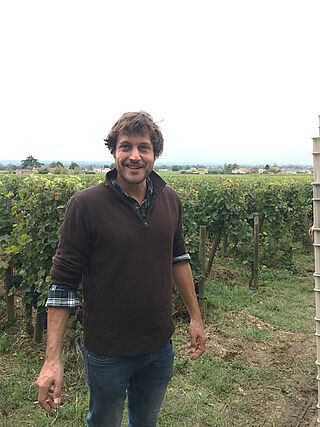
2019 vintage is a beautifull one. We are very happy about it.
We had a nice spring and were not impacted by the frost night during may month because of our old plant DNA. We still grow the old varieties, red tail Merlot, Bouchet and Prayssac, the developpement of those old grape varieties is always late, so we are less frost sensitive. The flowering process was also nice, a little failure of bloom but not to bad.
We were afraid before harvest because of the very sunny summer, lot of sugar and small grapes but the rain fall down few days before harvest, the grapes became bigger , more juicy and the potential alccolic degrees decrease to a normal rate. The malolactic process was very fast at Coutet, only 10 days because of the natural bacterias. The wine is already in barels starting the ageing...
Regarding the vine, we had no particular problem, no hail, no frost. Flowering has very smooth, few millerandage. Despite the great heat we had, there was no drought or water stress phenomenon, the rain was present at the right time.
Regarding the harvest, we picked healthy grapes (no mildew or powdery mildew), the grapes did not suffer from the heat (no wilting). They were picked up with an over-ripening for the Merlots and at maturity for the Cabernet, therefore top quality.
Regarding wine, 2019 will be a great vintage, we did some tastings and we have done, it is very promising, the wines are powerful with good structure, on the fruit, silky tannins.
Our 2019 vintage should be again an interesting one. We had no frost, no mildew pressure and our terroir allowed us to cope with the drought thanks to heavy rains at the end of July and to the clay in our subsoil. The selection and the blend have not been done yet and it is a bit difficult to tell you more about the vintage at this stage. Nevertheless we expect a good 2019 quality.
After a sunny and warm winter (February especially) spring came with low temperatures and some rains which made the vegetation growth pretty slow on the first half of the season. Rains were appreciated though, as we needed water to fill the soils with the rains that we didn’t have in winter. Luckily this didn’t affect production as Mildew pressure has been pretty low all along the year.
We went very close to a frost event at the end of April but luckily no damage at both Tertre and Giscours. (I think we will have to get used to these low temperatures in April). Then the sun came, vegetation grew rapidly and by the end of June and July we experienced the two the heat waves that you might have heard about. This started to concern us a little bit so we adapted the leaf pooling to these extreme conditions trying to protect the bunches to the sun.
August, thanks God, has been perfect : some rains and moderate temperatures that brought back the smile on our faces and helped the vines to go well through veraison. September started with a nice sun that lasted until the last week of the month when autumn came with lower temperatures and some intermittent rains.
Regarding our harvest decisions, two very different strategies for the two properties. At Giscours we started on Sept 11th with the Merlot. A little early you might think. Our strategy for the Merlots has been on 2 tempos : we picked the first half of the Merlots on a fresh/juicy/shining note and are leaving the second half for next week where we expect to have a more accomplished ripening and more velvety taste.
For the Cabs we didn’t play at all the same strategy. Due to the warm weathers and strong sunlight of July and September the skins were thick and full of tannins (which also created a natural barrier to botrytis) so we tried to wait for the skins to loosen and harvested when we felt the complete maturity. That’s why when the climate was starting to get rainy on the week of Sept 30th we decided to wait and push all the best Cabs for the following week. One month of harvest at the end (Sept 11th to Oct 12th ).
As said previously. One thing that was key at Giscours in our opinion was the management of the hydric restriction, specifically on the Cabs Sauv, as we believe that excessive hydric restrictions make tight tannins. Of course we took several viticulture decisions in order to maintain a consistent water availability (see email below) but more than that we took the opportunity to do a characterization of our terroir on a hydric perspective.
We used a tool called »pressure chamber« (that measures the pressure from a leaf to the plant to pump the water) to characterize the different terroirs and different ages of vine. We have the chance to have at Giscours some very old vineyards of the 30’s, 40’s, 70’s and 80’s. Of course in a vineyard of that age not all the vines are of the same age (every year we replace the dead vines for some new ones) and of course the root system of a young vine is not the same to an older one.
In the old blocks, we then separated the plants in 3 groups : 0 to 10 years, 10 to 20 years, older than 20 and we characterized their hydric behavior through the millesime. When harvesting we picked these 3 groups separately. In some blocks we passed 2 times, 3 times in other. And of course we adapted the vinification to each group as the type of tannin was not the same.
For the Merlot, beside the harvest decision in the cellar we tried to preserve the aromatic freshness so we did some very reductive fermentations and cold macerations to extract all the aromatic potential as possible. For the Cabernet we modified our extraction protocol versus the previous year to try to give a big focus on the delicacy of the tannins : we lowered the frequency and length of pumping over and the temperature of maceration (26 max 28°C) while on the other hand extended the length of maceration as did an average of 30 days on the skins. The result, so far, are very bright Merlot’s and tri dimensional Cabs with elegant structure and freshness (fresher that 2018 I would say).
At du Tertre of course the strategy was different.
A more concentrated harvest season with 19 days of harvest in total (started on Sept the 23rd and finished on Oct 11th). Maceration temperatures are around 24°C and length of maceration 21 to 24 days. A very conservative approach to try to preserve as much as possible the elegance and delicacy which is typical to this property were the mix of sand on the lower parts and clay on the higher parts of the hill give a constant water availability that prevents to any type of stress.
The wines have finished their malolactic fermentation and have been racked. The final blend is very close to be decided now. The yield is around 40 hl/ha that is good despite the little reduction in berry set on some blocks due to some humidity during the flowering of that blocks.
During summer, we had a quite dry and sunny weather with two heatwaves, a little one June 26th–27th at 37–38°C and a bigger on July 22nd to July 25th with temperatures going from 36 °C to a maximum of 40 °C. Thank god those very high temperatures didn’t affect the fruits as it happened before veraison.
During August and early September, the temperatures have been relatively high during the day but more importantly, cool during the nights which allow the fruits to keep great aroma freshness. By mid-September, the vines were thirsty though and we waited for the rain that was forcasted at the end of September to schedule harvest. The climate change is bringing a new paradox in the vineyard: for centuries the rain close to harvest was the nightmare of the winemaker because that would rot the fruits very fast. Today, with drier and drier summers, that rain is necessary to rehydrate the vines and help them to finish the maturation of its fruits. So when that rain happened we harvested the blocks »à la carte«: young merlots; then old merlots to finish with cabernet franc in three main harvest days spaced by a week in between each session.
Because of all that happened during the year, 2019 quality is great, the wine character is very balanced with beautiful maturity; freshness and complexity. During the fermentation we have put a close focus on light extractions so the wines are very smooth and silky as a result. So you have to expect a great effort for Guillot Clauzel that year that show the progress track we are onto at the moment.
So I am very positive on 2019.
2019 quality is great, the wine character is very balanced with beautiful maturity; freshness and complexity.
– Guillot Clauzel
Are you satisfied with the flowering process?
In 2019, the vine cycle quickly started with exceptional temperatures on February (28°) that led us to an early budburst (15 days in advance). Hopefully, the unusual freshness of May slowed the growth of the plant and returned us to a traditional calendar. By the end of May, the early summer weather and high temperatures accelerated the flowering process and demonstrated the incredible resistance of the vine which was not affected. The development ended very well thanks to a beautiful summer, giving us a very generous crop in September.
Have you had major weather escapades, drought or water stress or possibly failures due to hail?
2019 was a year of unprecedented weather and extreme seasons! Winter was short with a very cold month of January. February was exceptionally mild and it gave us fears of spring frosts. Fortunalaty, they were avoided thanks to the nightime mobilization of the team who lit fires on 5 separate occasions. After an unusual freshness in May, Spring ended with several successive heat waves, including two intense periods in June. At the end of July, we faced a hard period of drought that ended with a providential storm, gifting us with 40mm of rain. We had a beautiful summer, with alternating warm and sunny days with cool nights. Thanks to the exceptional month of September, the harvest took place in favorable conditions.
2019 vintage
The sugar concentration of the grapes, their phenolic richness and a natural acidity are signs of a great vintage. The wines are ripe, rich and aromatic. They offer balance, generosity as well as precision. 2019 is a wine of style and depth, a wine of balance, power and purity.
This vintage 2019 was indeed a rather complicated vintage, offering sharp contrasted seasons. A rather dry and mild winter, a cold winter where we had to fight against frost, especially on the right bank, then an extremely warm summer one after the other led to thrilling harvest, enabling us to gather beautifully healthy grapes, packed with luscious aromatics and a sharp fresh acidity.
This vintage undoubtedly will be more classic than its elder brother, 2018, yet will offer a glorious elegance and finesse, each terroir being highlighted and showing its best: the Médoc, Pomerol and of course Saint-Julien.
We have as usual blended all our wines by mid-December, and are since then patiently maturing in their barrels.
2019… as a winemaker, well it is the natural continuance of 2010, 2016 and 2018. Dry, a long and warm summer, with a nice finish and tiny bit of rain in September. The flowering was quite early and we were lucky enough not have rain during this period so yields were safe.
Now, if it keeps on going this way we are going to be able to make better wines every vintages, this is one of the side effects from global warming. But I am wondering how it will also effect the average alcool level. As a winemaker 2019 was nice, the quality level and acidity are quite high, we do have nice expectations on the ageing. During the vinification process, as the alcool was quite high we preferred to reduce the length in the vats and the skin and seeds contact, we would have easely have some rustic flavors otherwise. Also we kept quite a low quantity in new barrels, the tannins are quite high as well. Now there is going to be around 65% CS but we are still working on the blending at the moment.
Was markant war für Jahrgang 2019, ist der bemerkenswerte Zustand unserem Weinberg. Ein wirklich schöner Sommer hat es uns ermöglicht, die Ernte auf einen außergewöhnlichen Reifegrad zu bringen. Unser tief verwurzelter Weinberg litt nicht unter Wasserstress. Unser Cabernet Sauvignon profitierte weitgehend vom Sonnenschein.
In der Reifezeit sind unsere Weine sehr wohlschmeckend, fruchtig und großzügig zugleich. Sie bleiben unter 13° Alkohol, um das Gleichgewicht zu erhalten. Der Mund ist gut ausbalanciert, strukturierende Tanins schmelzen, wenn die Weine reifen, und wir können die Geburt und Entwicklung eines großartigen Jahrgangs beobachten.
Finally, the first traditional racking of our 2019 wines was just completed. These wines are now resting for at least 3 months.
Talking about 2019, and in order to soften the blow a bit of what is currently happening, I cannot resist my strong desire to share my memories of last year’s growing season and my first impressions of our blend. Reading this will not replace meeting you in person and tasting together, but hopefully it will give you a little idea of what to look forward to when we are finally able to do it.
An early spring and flowering
With a rainy and moderately cool spring, the 2019 vintage began its growth cycle with early bud burst from the first week of April. It was therefore only natural that we saw the first flowers appear from 23 May. Flowering took place under excellent weather conditions, suggesting encouraging potential for the harvest at this stage. An important first step in shaping the profile of the 2019 vintage had just been completed.
A mighty summer!
After a radiant month of July, the first reports of mid-veraison turned up around 10 August, and the head start seen in the spring had disappeared (several summer heatwaves).
At the very beginning of September, the vineyard was a picture of rare beauty. Despite the summer heatwaves, the foliage remained green and the bunches were thriving incredibly: the sight was stunning! The vineyard called for a stroll. We never tire of the generosity of nature and the great clay-gravel terroirs of Saint-Estèphe speak for themselves!
The benefits of an Indian summer
Someone who hasn’t experienced the famous Indian summers in Bordeaux cannot understand the magic that takes place in the days before the start of harvest! These hot and sunny days alternate with cool nights, allowing our grapes to reach perfect phenolic ripeness. Under these conditions, the Saint-Estèphe terroir provides optimum water supply to our vines. The vineyard team noted perfect sanitary conditions, with a total absence of the risk of rot. The gentle rains of mid-September that preceded the start of our harvest, far from being worrying delighted us by bringing freshness and good balance to our grapes. The tannins of our Cabernet Sauvignon are refined while our Merlots have turned out juicy and expressive.
The harvest of love ...
The first snip of the secateurs took place on 24 September in our Merlot plots. Without interruption, the Cabernet Sauvignon was picked until 10 October, in complete calm. In the meantime, the Petit Verdot was picked on 26 September and the Cabernet Franc on 2 October. In 17 days, the entire 2019 harvest from the 70 hectares of Phélan Ségur was brought into our vat room!
All the panache of a great vintage to come!
The vineyard team was proud to entrust such beautiful grapes to the cellar team which, contented, was already listening to this new vintage whose quality it could only transcend. At the end of the first fermentations, the quantitative and qualitative potential was confirmed, and we were writing one of the finest pages in the history of Phélan Ségur!
A promise kept: power and freshness!
The vintage has been blended and it has kept its promises.
The colour is a deep red with purple reflections. On the nose, aromas of ripe fruit (black cherry, blackcurrant, blackberry...) are made more complex by toasty and liquorice notes.
On the palate, the impressive attack leads on to fleshy and crunchy fruit. This delicious taste comes from our Merlots. Some of the old vines (»Peymoulin« and »Bénéteau«) near to the river even behaved like real Cabernet Sauvignon, with more than 5 gram of tannin and 980 mg of anthocyanins!
This harmonious blend is kept taut by nice freshness at the end of the palate and great aromatic length. Here we find the breeding of the great Cabernet Sauvignons that makes up the backbone of the 2019, at 56 % of the final blend; thanks to a good level of acidity, they help to balance this vintage with its high degrees. Our Cabernet Francs, though planted in 2013, were selected for their floral notes and a very fine texture on the palate, synonymous with elegance.
Combining the qualities of concentration, tannic power, structure, ripeness and length, 2019 also has the freshness necessary for the balance of great Bordeaux wines. It joins the club of 2009, 2010 and 2018 with brio.
Analytical details
Blend: 56 % Cabernet Sauvignon, 42 % Merlot, 2 % Cabernet Franc
Alcohol: 14.5 %
pH: 3.8
TA: 3.1 g/L
Total polyphenol index: 81
We are very (very) satisfied with the 2019 Château de Pressac. Even if itw as very dry, our vines never suffered too much (thanks to the limestone which is always fresh), and never stopped growing.
It resulted in a concentrated vintage with vey ripe fruit, creamy tannins and nice acidity. We are very optimistic for this vintage at Château de Pressac (even better than 2015, 2016 and 2018 ?... wait and see)
In resume: Warm winter and very hot summer, Cool and wet spring. Very nice back season.
«Yes we had!»
We had 1.5 °C above the average of the past 30 years.
We had 20 % less rain than average.
We had frost (and hail in other neighbouring areas) so in some plots, the harvest was almost reduced to zero.
We had no mildew pressure (as we had for vintage 2018)
We had some rain during the flowering, having some coulure, but actually more positive than negative (unless you focus only on volume). Then during the summer we had temperature nearby 40 degrees during almost one week bringing a long lasting »veraison« (colour changing). Than, in September we had intermittent rainfall, which is not easy to manage during our harvest and increases the threat of rot (especially in Clos Fontaine and Robin where we harvest by hand). According to our weather data we can say that the rainfall overall was approx 50 % lower than the average from 1981–2000 and 20 % lower than the average over the last 30 years. We had rain in spring but it was not enough to recharge the water table. The heat of July caused some vines shutting down, slowing the progress to maturity. Fortunalty, our eastern and hight Terroir are perfect to support such extreme wether conditions.
The flowering began end of May until first week of June. The veraison began start of August (a few plots end of July, in our Chateau Bouty for example) it was helped by the rain fall of end of July (about 30 millimeters during a short summer thunder storm). Finally was not much later than the 30 year average (not even a week) and only one week later than 2018. As we work Organic and Biodynamic, we were very happy that there was no mildew or black rot this year.
I am very confident in the quality but more unhappy on the volumes as the coulure and the little spring frost had little consequences in some parcels’s volumes. So far, the wine is coming in Barrel and is one of the best juice I ever produced. I am very happy of the coming primeur tasting for this promising campaign!

The 2019 Harvest
from Premiere Presse No. 58 Oct. 2019
«Saved by the rain!» shouted Alexandre Thienpont to me from his tractor, racing through the vines towards harvest reception with no time to do interviews this time. Rain at the end of July and beginning of August really did come to the rescue for the very thirsty, long-suffering vines and set up the veraison and ripening processes in near-ideal conditions. Except that in late August, a canicule (almost a dirty word in the Bordeaux vineyard these days), or heat-wave, set in to start driving up alcoholic degrees, lowering acidities and concentrating the juices to the extent that potential volume was falling daily.
Then at last came September showers, just in time to rebalance the grapes to some extent and relieve some of the stress, not just of the vines but of the growers, too. Amazingly, acidities held up well, and 2019 promises to have a «fresh» dimension that few producers had anticipated. Incredibly, in northern Spain, where rainfall was far lower than in Bordeaux, good levels of acidity also prevailed.The interviews below were made over recent days.
Loire
Concerning the vintage 2019:
We have had a small harvest in quantity. The wine is excellent in quality. Climatic conditions: we have had frost on 5th April. The harvest has been divided by two. But we had a very beautiful harvest in 2018. We will have to remain longer on vintage 2018 which is of very very beautiful quality, and we will not lack of wines anyway.
In Sancerre, summer 2019 has been very hot.
In term of climate, the difference between 2018 and 2019 lies in September: in 2018 it was hot nights and days; in 2019 September was hot as well but the nights were cool and there were dew in the morning.
Vintage 2019 seems to express freshness and minerality which gives us balanced wines.
In 2020 so far we can say we don't have a cold winter, it is quite gentle and wet. We are waiting for spring wondering if there will be frost or not.
The 2019 vintage requested some work, we have had some frost this year again, in april that took about 30% of the crops, after that climat got extremely dry except 10 days of big rain in june. We only had to treat one time with copper (the organic controler said he had never seen that before!)
Though we had to help the vines to cope with the extrem heat and dryness making treatment with herbal teas and teas of compost to help sap circulation. here one can see how much biodynmaic agriculture is a help when the climat is unusual, the vines managed to go through the summer. Very small berries that stayed the same way until mid september and, with the first rain maturity could start.
Harvest was mainly begining of october, we went through the vines 3 times (over 3 weeks) wines are still fermenting now but the potential looks great for the moment
2019 will be a great vintage in Anjou, however volumes are lower than usual. The end of winter was very warm with some temperatures close to 20 °C in february and not very humid so soil works started quite early in the season. Budbust has been very early, starting around mid March for the youngest vines and unfortunately hard frost came during the night of the 3rd to 4th April. the 3rd of April was a quite cold day but with some rain in the afternoon and hail at the end of the day, the temperature dropped quickly at night, already close to 0 °C at midnight and severly under at 2 am. I did prepared some fires in the places usually most subjected to frost but temperature came too low and too quickly to -3, -4 °C and heavy damage was deplored on several places as the oldest vines of le Clos des Mailles, a place called Jeanne, le Quart des Noëls, most of the Cabernet franc, and Sauvignon blanc. However the main part of the vineyard, more than half, situated in the highest elevations of le Clos des Mailles and Varenne de Chanzé remained unharmed. Later we noticed both Sauvingnon blanc and Cabernet franc managed to restart a honorable crop on secondary buds, not for chenins. A second night of frost happened the 6th of May didn’t harmed more the vines.
May remained colder than usual and dry, resulting in a short growth of the vegetation. June and July were still very dry but warmer, allowing globally good conditions of flowering. Early flowerings on Cabernet franc suffered colder weather and substantial coulure is noticed. Overall the disease pressure is low and very few sprayings are needed. the weather remained very dry and a very hot week at the end of june made grapes suffering to correctly put on volume, except for old vines feeding on deeper root system. With very hot conditions in the end of july, some grapes litterally roasted in a proportion never seen in Anjou.
Arriving in August, we enjoyed several small rains and also fresh nights over the three first weeks of the month allowing a relief for the vines and a correct start of maturation. The end of the month is hot and dry again keeping away any risk of early botrytis. first maturity checkings are very reassuring, with this extreme vintage in term of drought and temperatures, acidity remained very high and degrees reasonnable. Harvest started the 6th and 9th of September with sauvignon blanc for Laïka, later than 2017 and 2018 but slightly earlier than a longer term average, then from 12th to 20th September for dry chenins, 30th september for Cabernet franc and finishing the 5th October to pick the few botrytised chenin grapes left behind.
In 2018 I found that the center point of the vintage was to pick chenins at the right time, avoiding excessive maturity to preserve freshness and purity in the dry wines and saving acidity that tended to be on a lower potential. In 2019 acidity is undoubtly here, in all the wines, and they’re all showing great expression, with freshness and a crystalline tension. Great attention has been given to Orion Alpha, Cabernet franc was in danger in such a warm and dry vintage and the risk was to struggle reaching plain maturity and in the end I’m very pleased to taste a very juicy Cabernet franc, very precise with expression on the floral side with no vegetal or rough finish. Laïka is very nice with this extra acidity giving wings to the wine. for Chenins, La Varenne de Chanzé, le Clos des Mailles and Pluton are showing very well, very pure and expressive, already very promising. Le Quart des Noëls has been picked and fermented together with »Jeanne«, grouping on this vintage the two centenary old vineyards in one. These two plots were very frozen and volumes were ridiculous to keep them aside, Le Quart des Noëls is predominant in the blend as Jeanne gave a very low crop (and would have been unsignificant in le Clos des Mailles blend) for now this wine is showing an amazing power lifted by a beautiful acidity.
2019: The winter and early days of spring were quite mixed in terms of weather – the temperatures were sometimes surprisingly high for a while before suddenly dropping again.
These sharp drops in temperature, when they occur in late April or start May, can freeze the buds. Unfortunately, we now have to worry about this every year but, in 2019, our vines were spared. We were luckier than a lot of other winegrowers in France.
In May, as the vine had woken up fairly late, we thought we would be harvesting at the end of September. We then had a hot, dry summer. The only upside of these types of conditions for the vines : not much work required to manage the grass and few treatments. The downside : water stress in the young vines, the scalding of the grapes when the sun is too strong, a rapid fall-off in acidity in the grape berries, and a drop in yields.
So, summer 2019 followed and was a repetition of summer 2018. It is now obvious that drought and heatwaves are no longer occasional occurrences, they are, and will continue to be, all part of today’s climate. This raises a lot of questions about the future of our activity and the wines we produce. We are putting in place those solutions available to us :
– Work on the plant material bequeathed to us by Henry Pellé. As well as being a winegrower, Henry was a vine nurseryman until the early 80s. Les Blanchais, Le Carroir, Les Cris are still planted from massal selections that he himself carried out. Here, we are taking the wood from the vines whose grapes ripen later, which helps create a natural acidity and freshness in the juices. Our recent and future plantings are the result of this work.
– The planting of trees near the vines to provide shade and add biodiversity. We have gone for fruit trees (the blossom for the bees, the fruit for us).
The intense heat brought the start of the harvest forward and we commenced picking on 13 September. We had the same challenge that we always have with these hot vintages : harvesting at the start of aromatic maturity as the grapes can quickly overripen. The duration of the 2019 harvest was unprecedented, after 12 days’ picking all the grapes had been brought into the winery – a big thanks to all those who made this possible!
We would mention that, in recent years, some of our staff members have retired after 40 vintages at the domaine, an entire generation is passing on the baton. In the vatroom, the 2019 juices present a profile similar to those of 2018 – wines that you can enjoy any time. These last two vintages are sunny, meaty and succulent, yet also crisp and mouth-watering. This is thanks to the quality and freshness of our terroirs.
Wir freuen uns sehr über diesen Jahrgang, der als wärmster und trockenster Jahrgang der Loire gelten wird, der uns jedoch Weine von seltener Finesse und beeindruckender Frische beschert. In der Tat hat die Tatsache, dass die Pflanze seit mehr als 15 Jahren auf Pflanzenebene nicht mehr gekürzt wird, dazu beigetragen, die Wasserversorgung zu schützen und ihre Bedürfnisse so gut wie möglich zu regulieren.
Wir hatten eine komplizierte Blüte mit etwas Farbe und Kleinbeerigkeit und auch starken Frost am 4. April und am 3. und 4. Mai, der uns auf dem Landgut stark beeinflusste. Wir haben Dank der Kerzen die Erde warm halten können.
Die Ernte und Weinbereitung liefen ohne Sorge. Eine Infusionsarbeit in diesem Jahr ermöglichte es uns, sehr feine Tannine zu bewahren, eines der größten Jahrgänge der Domäne zusammen mit 2018.
Champagne
2018 was a miraculous vintage. We did not dare to imagine a 2019 vintage worthy of years in 9 ...
And yet ... 2019 seems an unexpected vintage.
Especially since the weather was for the most confusing: After an early start, the vegetative cycle is quickly slowed down by spring frosts in April (1/3 of the vineyard affected here) and a cold month of May. The flowering takes place from June 17 to June 20, at very classic dates for Champagne ... but soon reveals a very important «millerandage» (very small grapes). Then the year is marked by a tilt, two peaks of heat wave in June and July (record 42,5 °C in the vineyards) and again high temperatures in late August. Scalding, usually limited in Champagne is a marker of this year.
So that:
– The volume of harvest in the Côte des Blancs is less than a normal year ... We will not qualify this crop of small in quantity, but of »lower average«.
– the harvest dates were earlier than expected, the vegetative cycle from blossom to harvest being much lower than «100 days» of the 1980s or even 89 days of the last decade. The Champagne harvest «opens» in 2019 ... 81 days after flowering.
Nevertheless, this «puzzling weather» leading to accelerated maturation kinetics raises questions. While our parents harvested by referring mainly to a sugar / acidity indicator, today we have to invent others criteria (aromatic maturity, skin colors ...), as a «2019 Chardonnay of 85 days at 10 ° 6 potential» does not have the same tasting maturity as a «Chardonnay of 100 days at 9 ° 9 of the 1980s» ...
So we have waited, as in recent years, to harvest our Chardonnay at an «optimal aromatic maturity» between 88 and 95 days ... and harvested from 13 to 23 September.
The result is unexpected (compared to our July pessimism):
– grapes were 100 % healthy: no botrytis,
– alcoholic potential unimaginable: the average is 11,80 % vol ... nearly 1 point higher than the average of the best years.
– the acidity and pH are very satisfactory.
– The aromatics of juices and wines at the end of fermentation ... are very promising.
We are so happy winegrowers:
even though the volume 2019 is not important, the quality of the wines seems to be so outstanding that we consider to have the essential: great juices to elaborate rare Champagne. We dare to add: «What else? ...»
We are confident:
we know we have made the most of an atypical year. We think that we have something exceptional in our tanks. But let’s be careful before comparing this 2019 vintage to others … Let’s wait patiently to discover these «vins clairs» in spring.
How would you describe the growing season of 2019?
Difficult and intense! Start early. First plowing end of Feb. After to cold with frost and then to warm in July with sunburn on the grapes.
When was pruning finished?
Begin of March
When did budbreak happen?
Before the frost! ;) around 10th of April. The frost was 3 time: 17th April, end April, and begin of May. The worst for us was the first and was strong for the Chardo.
When did you start plowing?
End of Feb we had 15 days quite warm and dry. We decided to warm a little bit the soils on a few plots. All the vines had the first plowing on end of April.
When did the flowering arrive?
Full flowering on the 10 of June
Which were the big challenges?
To be in advance but not too much. In fact, with extreme weather, we we always looking for the best time to do or not to do the works. We made some mistake I believe (for example, I didn't exept that the sun will burn like that the grapes. And 5 days before the warmest day – 41 deg C – we did a cutting of the leaves … ) now I know for the coming years.
What was the average yield? How much did you loose?
9 000 kg / ha. We lost around 15 % by frost – 5–10% by sunburn
How did fermentations proceed?
Really well ! Better than in 2018. There was enough Azote to have a good works for the yeasts. Grapes was sometime warm during harvest, but sometime we were waiting until the morning after to refresh the grapes or we decrease temperature of the juice. All the wines were finished to fermented at Christmas.
What other vintage(s) would be comparable?
Difficult to know. Same richness than 2018 but more acid. May be a little bit like 2009.
We had also the unique thing of high alcohol. There is some wines with more than 11,80 %. So with second fermentation it will be at 13,2 …
Sensation of alcohol change a little bit the perception of our taste. This is new for us. After, during ageing in bottles, the wines could getting closer and the strong minerality could manage really well to get top balance. So it could be like a 2002, 2012 in a certain way… but this is with time that we will know.
During the flowering process, we had a period with many doubts due to the bad weather, so we realized 2 homeopathies with some meadowsweet to protect the vineyard as much as possible. There was no water stress because the beggining of the year was very wet and rainy so the groundwater was almost full, and thanks to our deep root system (between 10 and 15 meters with the alternative methods) there was no problem about it last year. We’re lucky, we only had one plot affected by hail.
About the 2019 vintage, we make our blenging in march, so it’s a little bit early to know the features of it but at the moment, there is a very good balance between sweetness and acidity, the physiological matury was excellent as well as for the health status of the bunches. So wait and see the result at the end of the winemaking process ;-)
New year: new goals!!
In the vineyard, 2019 was 9,45 hectares without any chemical. This year, we are growing to 10.2 hectares with the same intention to protect the plant. 100% of the surface will be nourished with our home-made compost, and a new double grafting project of Meunier on Pinot Noir is coming, following the creation of our own selection massale.
Concerning the final wines, we are improving a lot on sulphur reduction. In the meantime, we launched an experimentation to replace oil-producing sulphur by 100% natural sulphur.
2019 was a unique and very changeable year. It brought its own stresses for a great many producers, while harvesting passed without a hitch. The end result has inspired enthusiasm amongst winemakers, surpassing expectations. The weather was hot and dry, but the wines are promising a freshness that will delight fans of Bourgogne wines, with an indulgent side to boot. Since the start of the 20th century, every vintage that has ended with a «9» has been wonderful. The only downside to this one is below-average volumes.
This year 2019, because of the capricious climatic conditions, yields will be low. We are expecting a small harvest but of good quality and rich in concentration. The weather in this early September is ideal: fresh nights with hot days. Harvest has begun September 10th. The 2019 vintage has not been easy but it is promising.
Update: The special weather conditions gave us small yields, we had some hail in the South of Beaujolais, but thanks to that the wines are rich, fruity and have a high natural degree. They are well-balanced and have a good structure, we had already a chance to see it with our Beaujolais Nouveau. We expect a good aging potential.
LA CHABLISIENNE
The harvest started at La Chablisienne on the 9th of September with the plots which had ripened earliest and finished at the end of the 4th week of September, a relatively long harvest period for these vineyards. The initial natural alcohol content was high and continued to increase until the end of the harvest. At the moment the juice is concentrated and beautifully aromatic and levels of acidity are astonishingly good. They are quite close to the juices of 2017 and 2018. The alcoholic fermentation continued non‐stop and has now finished. The first malolactic fermentation has barely started so we need to wait until it is finished before we know the final Ph and acidity levels. By comparison with a full year’s harvest the total yield for the appellations Petit Chablis and Chablis 2019 is down by 20 % and the Premiers Crus and Grand Crus is also down by roughly 40 %.
THE VINTAGE
In common with a great number of previous vintages ending with the number 9, 2019 bears all the hallmarks of being exceptional. As always, following the harvest, it is the conscientious vinification and maturing which will mark the differences between producers. Will this vintage attain the heights of perfection of La Chablisienne’s Chablis 1er Cru 1959 which was tasted last year? It certainly has the potential …
The legend of great vintages in years ending in 9 appears to hold true for 2019. This year, we endured adverse weather conditions, including a severe drought that led to disparities in yield. Fortunately, moderate temperatures allowed the grapes to mature well, resulting in a harvest of exceptional quality. This 2019 vintage will undoubtedly be fabulous.
THE CHANGING SEASONS
After a mild winter, the vine growing cycle started early and the mid-bud break stage was reached in early April. However, cooler temperatures with several frosty nights caused damage that varied greatly according to the sector. This cool spring was not conducive to growth, which then slowed down. In view of the weather conditions and susceptibility to powdery mildew, treatments were started in order to maintain optimal protection for both Chardonnay and Pinot Noir. Flowering started in June and lasted for three weeks. Strong variations in temperature and rainfall during this period led to millerandage and coulure, and hence to discrepancies in bunch development. Despite a warmer-than-average summer with recurrent heatwaves and a lack of rainfall, the vines held up and veraison started slowly in late July. It continued with a little redeeming rainfall in August, and ripening developed with very favourable weather. The harvest took place from September 12th to 17th, in summery weather. Early-season weather and drought during the summer had a significant impact on yield.
THE GRAPE HARVEST
We started harvesting Chardonnay on September 12th to benefit from the cool mornings. The quality of the Pinot Noir grapes was obvious, with excellent grape soundness and an almost perfect balance of sugar and acid.
VINIFICATION AND FIRST IMPRESSIONS
The wines are developing a very Burgundian elegance: the colours and tannins quickly emerged from the Pinot Noir and the juice appeared fresh and full of fruit. The Chardonnay have good acidity, harmoniously combined with great maturity. The wines are now in barrels. Our Vosne-Romanée plots suffered more than others from the adverse weather and finally produced a small harvest. The 2019 yield has decreased over the entire estate with 23 hectolitres per hectare. The wines have texture, elegance and balance: clearly another great vintage from a year ending in 9.
Zu allen Weinen
M. Vincent Mongeard thinks that it is too early to speak about this vintage: just at the beginning of his life. The maturing in the cellars is very important and we will be able to resume all at the end of this year. Certainly, in November or December 2020 when the wines will be ready for bottling in winter 2021.
Zu allen Weinen
2018 was almost like the milk in the hot pan, i. e.: you leave 15 days early august, when you are back, it is so beautifull and mature that, even if not easy, if you do not run and harvest, you are wrong. At the DML, that was The decision. You can expect what the wines are. Superb. You will follow me when you taste them, I promise.
2019 is an other story. Nothing to see. It has been dry, very dry, hot, very hot, the maturities were simply fantastic, we picked many, many grapes but so little juice. At the DML, 35 % off in volume, but wacht out the powerfullness : over 13,75 %. Big wines. If you get a chance to drink them, waaaooouuuhhh.
Zu allen Weinen
Der Jahrgang 2019 ist ein Jahrgang, der mehrere Perioden übermäßiger Hitze und Trockenheit erlebt hat. Die Blüte passte gut zu einem guten Traubenertrag, der eine gute Ernte voraussagte, der jedoch durch die Trockenheit zum Zeitpunkt der Ernte erheblich gemindert wurde.
Die Reben litten im Sommer mäßig, und glücklicherweise gab es vor der Ernte einige Tage Morgentau und Frische, die es den Reben ermöglichten, sich wieder zu beleben und die Reifung ordnungsgemäß zu beenden. So scheinen die Weine trotz eines heißen Jahres Frische und Kraft zu haben.
Quality of the extra harvest but quantity in decrease it goes from 40 to 50 % of decrease in volume. I have never seen a harvest with so many small berries very «millerandées», very good alcohol/acidity balances, perfect Ph, quite a lot of tartaric acid but a very low juice yield. We are on a volume level of a vintage like 1995.
We have thick skins, sugar, flesh but little juice and a sanitary state of the harvest close to perfect. We are on a very great vintage according to certain style 59 but let’s not get carried away too quickly ... I think that in red we can perhaps say it but less certain for whites althought as always there will be exceptions on the great terroirs and at the great estates !
In vinification it will be necessary to be very gentle in the extractions because not all of them had reached perfect maturity. I think once again that the Côte de Nuits is doing even better this year !
– Emmanuel Reboud
Jura
2019 has a good overall quality. No doubt about the qualities of the wines, especially in Château d’Arlay where we have a vast majority of old vines. I’m quite confident that we will do some interesting wines even if it’s not so easy. Nevertheless, the Arlay terroir never let us down. But …
We did 45 % less production than in 2018, and it is quite low, far too low. The causes are two frost periods in end of April/May and, in summer, two periods of very high temperature (over 40 °C) which burned the fruits or dessicated them. 2019 is so a «hot» vintage with high sugar rate at the harvest but a good acidity which helped us. No hail, thank God.
Rhone
EIN GROßARTIGER, AUSDRUCKSSTARKER UND SCHÖN STRUKTURIERTER JAHRGANG
Nach einem regenreichen Frühjahr 2018, bestätigt der Jahrgang 2019 eine Rückkehr zu normalen Frühjahrsregenfällen (96 mm gegenüber 280 mm im Jahr 2018).
Die schlechten Erinnerungen an den Mehltau des vergangenen Jahres veranlassten die Winzer, von Beginn der Saison an äußerst wachsam zu sein. Der phytosanitäre Druck blieb jedoch nahezu aus. Andererseits werden die Hitzewelle Ende Juni und der zu trockene, heiße Sommer in Erinnerung bleiben.
Die Weinlese begann langsam aber recht früh in der Saison, um die früh reifenden Rebsorten vor der Überreife zu bewahren. Die Regenfälle vom 18. September führten zu einer Steigerung der Saftausbeute und einem ausgeglichenen Most. Der perfekte Gesundheitszustand der Trauben ermöglichte es, 2019 sehr farbintensive, geschmeidige und großzügige rote Châteauneuf-du-Pape zu produzieren. Die Weißweine sind vollmundig und verwöhnen mit einem langen Abgang.
EIN SEHR HEIßES UND TROCKENES JAHR
Die Herbst-Winter-Regenfälle (460 mm) leiteten die Vegetationsperiode ein und versorgten die Böden mit guten Wasserreserven. April und Mai waren relativ kühl, mit Phasen aktivem Wachstums gefolgt von Verlangsamungen, ein Phänomen welches zu Verrieselung hätte führen können. Glücklicherweise war dies in 2019 nur sehr selten der Fall. Die Vegetationsperiode war sehr trocken (mäßige Regenfälle im Frühjahr, sehr geringe im Sommer) mit nur 158 mm Niederschlag (gegenüber 530 mm im Jahr 2018, 185 mm im Jahr 2017 und 230 mm im Jahr 2016). Sehr heiß, lagen die Temperaturen zwischen dem 1. Juni und dem 15. September im Schnitt sieben von zehn Tagen über 30 °C. Ende Juni brach in der Region eine einwöchige Hitzewelle aus, mit rekordverdächtigen 44,3 °C am 28. Juni (in Carpentras).
Trotz dieser klimatischen Exzesse hat sich das Laubwerk erstaunlich gut angepasst, wohl auch weil dem Rhône-Korridor, im Gegensatz zu anderen südlichen Weinbergen, der Heißluft-Effekt erspart blieb. Der Wassermangel hat vielmehr die Größe der Beeren beeinflusst, welche letztendlich eher klein blieben. Die Trauben schlossen sich, dank einiger weniger Sommerregen, erst gegen Ende der Veraison. Unter diesen Bedingungen war der phytosanitäre Druck fast nicht vorhanden. Zum Zeitpunkt der Weinlese waren die Trauben gesund, jedoch mit einem relativ geringen Saftertrag. Die willkommenen 15 mm Niederschlag vom 18. September, ermöglichten dem Grenache seine phenolische Reife zu erreichen. Das Ergebnis waren feste Beerenschalen, intensive Farben und eine pure Aromatik. Die Erträge lagen leicht über dem Durchschnitt der letzten Jahre.
FARBE, SEIDIGE TEXTUR UND GROßES POTENZIAL
Die Weißweine von Châteauneuf-du-Pape haben exotische, Pfirsich- und Zitrusfrucht-Noten. Sie sind vollmundig, mit einem langen Abgang. Die Rotweine, insbesondere aus Grenache, erforderten recht lange Maischestandzeiten. Sie haben Aromen von reifen Früchten, Himbeeren, kandiertem Ingwer, und für Syrah, Menthol-Noten. Am Gaumen ist die Tanninstruktur elegant, mineralisch, gut konzentriert, die Säure bleibt dezent. Besonders schön gelungen sind die Assemblages, wenn diese noch während der Maischestandzeit stattgefunden haben. Dem Jahrgang 2019 kann schon jetzt ein sehr gutes Alterungspotenzial vorausgesagt werden.
Syndicat des vignerons de l’appellation d’origine Châteauneuf-du-Pape
Languedoc / Roussillon
2019 will remain in memory as a «heat-wave vintage». Marked by a lack of water in almost all the region, we decided to start harvesting the whites on August 20th, two weeks before the harvest time of 2018. This was done in order to maintain a good level of acidity and freshness in our wines. At SO Vignerons we never acidify our white wines. As the result the whites and rosé are ripe yet fresh with a lovely balance.
For the reds the harvest started the first week of September once again to avoid high alcohol. The wines are very fruity, fresh, easy and elegant.The harvest ended with Cabernet Sauvignon on the 3rd week of September but again without being over alcoholic with never more than 13 % ABV.
In terms of yield we are just below an average vintage but 15 to 20 % more (depending on the varietals) than last year as the sanitary conditions have been very good from the flowering to the harvest.
The 42nd harvest at the Mas de Daumas Gassac began on Monday September 2nd 2019! It lasted about two weeks and ended on Saturday 21 September with the picking of our star grape variety, Cabernet Sauvignon. This year we were lucky enough to have a team of 60 pickers, representing more than 16 different nationalities in the beautiful Gassac valley!
We are indeed seeing the unpredictability of global warming in agriculture. Temperatures soared to 43°c in summer and there was a blow-torch effect in the south of France. Due to our altitude, up to 650 m, our vineyards escaped this but we did lose around 20 % of our young plantation as the roots have not yet had the time to establish deep enough.
Due to the heat and drought, our number 1 enemy in 2019, was the wild boar. We are surrounded by the garrigue and our vineyards are little islands amongst the wild vegetation. The wild boar enter our vineyards that are protected by four lines of electric fencing and cause absolute havoc and devastation in the search of moisture. They are not looking for the sweetness of the grapes but instead their survival instincts to nourish with the liquid in the grapes.
We are very happy with the grapes that we managed to save. Great quality and good fermentation in the cellar. We proudly look forward to presenting the 2019 vintage, but you will have to wait a bit as we generally age our wines for two years in oak before bottling.
Zu allen Weinen
Südwestfrankreich
The last harvest was a good one, in spite of a rather tricky start of the season in spring 2019. We first lost a few grapes due to morning frosts in April, others later in the season due to cool, rainy weather during flowering.
We were worried about summer drought too, but finally without reason. The vines were able to fetch the water necessary to maintain leaf growth and grape ripening in deeper layers of the soil. They, therefore, suffered less from the heat wave in June and July. At the beginning of August, 60 millimeters of rain in three days relaxed the atmosphere, ensuring that maturation went on under great conditions, with warm and sunny days and cool nights.
In short, a good harvest a bit low in quantity, but certainly strong in quality. Beautiful red and white wines are currently ageing in our cellars.
Piemont
2018–19 winter was quite dry, with good sunny days and warmer temperatures than usual (just few degrees more); cause of that and since we had a good water reserve thanks to 2018 vintage, the season started earlier, but then temperatures dropped down, slowing a bit the shoots growing.
After we had good weather until the flowering (end of May-beggining of June) then it rained a bit, so we had lower production per hectar cause it influenced a little bit the flowering. Then the weather was quite normal with good sunny days, not too warm, except a couple of days at the end of June, and another couple of days in mid of July, when we had really warm days.
So we had perfect weather condition until the 5th of September, day when we had a big rainstorm also with 10 minutes of hail mixed with rain (latest hail of ever), this could have been quite bad, but luckily the weather helped us with sun and warm temperatures so the hitten berries dried out without giving few damages in quality, but we lost a small part of the production too. The damage given by the hail was different in each vineyards, we had some where there was almost no damage, until the most hitten one in our property with a 5–6%.
Getting close to the end of the harvest we had a few drizzling and cloudy days spread out in a couple of weeks, but didn’t influenced the quality of the grapes. The harvest, for us, started the 7th of September with Dolcetto and ended the 13th of October with Nebbiolo.
Anyway at the end we are quite happy about 2019 vintage, the wines are promising good, more of what we expect, and we are looking forward to see the results, until now seems a really elegant vintage, not huge and massime body wines, but really fresh-fruity aromas, and also lower alcohol, so really fine wines.
When comparing the 2019 vintage to the previous ones, it is considered late, this is due to slower and more gradual vegetive growth.
Thanks to the good weather conditions in the months of July and August with warm days and well distributed rain that guaranteed a good water storage for the vines and permitted the vegetive development well without creating any problems to the vine maintainence.
The months of September and October were mostly warm sunny days followed by cooler evenings, this difference between daytime and night time temperatures allowed the grapes to reach both a good technical maturation (so sugar, acidity and PH) and a good phenolic maturation (anthocyanins and tannins).
The harvest of the Dolcetto, Arneis and Barbera grapes was around the same time of the 2018 vintage. Whereas the harvest for the Nebbiolo grapes was later by about 10 days.
From these wines we are expecting good structure and balance.
2019 VINTAGE
Unlike last year, which was particularly precocious, the 2019 vintage will be remembered for its decidedly more conventional course. The year in the vineyard began slowly due to delayed winter season lasting until February. This resulted in a delay in the arrival of spring, which brought about a period of rain and low temperatures until the middle of March. Nevertheless, plant growth resumed as per normal, and though it was slowed down initially by abundant rain in April, this also allowed a considerable amount of water to accumulate in the soil, compensating for the minimal rainfall during the winter. The changeable weather with mild average temperatures continued throughout May, confirming a delay of around two weeks compared to the growth patterns that had been seen over the previous few years, but in line with more traditional development. The high temperatures during June combined with the availability of water in the soil to create the conditions for rapid plant growth, which required vine growers to take great care over containing any plant protection issues. The hottest period in the season was recorded between the last week in June and the first in July, followed by days on which mild temperatures alternated with light rain.
First week of September brought a couple of rainy days, but the intense hailstorm that hit the Alba surroundings on the 5th of the month did not hit the Barbaresco appellation. Second week of the month showed bright sunny skies and intense night/day temperature difference, while the third week was warmer than average. The good weather lasted until the middle of October helping a proper ripening of the grapes. Harvest started in Barbaresco on October 7th and when a rainy day arrived on the 15th of the month, over 90& of the Nebbiolo crop was safely in house. A balanced crop with good sugar, acid and color levels should guarantee excellent Barbaresco wines from 2019.
Now the wines are resting on the lees with batonnage every 20 days.
The vintage for us was very good, I would say almost excellent, even if with very hot weather. Since the temperatures were very high, the wines of the 2019 vintage have an high alcohol content, not only the reds but also the white wines.
Fortunately, we were not affected by frost and hail, so the health of the grapes was good.
Compared to the 2018 vintage, the quantity was lower (about 20% less) but the excellent quality. In our area, to reach a good balance of ripeness (sugars, acidity, anthocyanins and tannins), the harvest lasted until 10 October (usually in Roero zone, in the last years the harvest ended earlier).
This was good because it allowed to enjoy days with high temperature range between day and night (an important aspect for the maturation almost of the tannins of Nebbiolo, which give great aging potential).
The climate has changed a lot and we have had very heavy rains during the spring and summer, not well distributed, but in peaks. Then the rains decreased and the weather was dry in late summer-early autumn, so we harvested healthy, concentrated grapes, respecting the timing for excellent grape quality.
Unfortunately in recent years the biggest problem is mild winters and little snow. Snow represents a slow resource of water during the months. In recent years, unfortunately, we had winters with abundant rains, but little snow as temperatures are too high.
I our opinion the wines of the vintage 2019 are of great structure and great olfactory potential.
Voerzio lässt nur kurz durchblicken, dass die Ernte perfekt verlief und dass Sie großartige Ergebnisse erwarten. Ansonsten legen Sie den Blick noch mal auf die jetzt verfügbaren Jahrgänge 2017 und 2018.
We are ending our harvest and has been great, we expect a great quality!
As you probably know, on September 5th a big storm with hail damaged many vineyards in Langhe district. From 2015 we have decided to protect 100 % of our vineyards with anti-hail nets, so we had no damages at all. The quality of the grapes has been preserved and is very hight.
In these days we are starting to sell our Langhe Nebbiolo 2017 Disanfrancesco, Barbera d’Alba Il Cerreto 2017, Dolcetto d’Alba Priavino 2018. These wines are really enjoyable from the beginning, but they have all a very good ageing potential.
Wines from 2017 vintage are extremely rich in fruit, silky, roud, very fine. The Dolcetto Priavino 2018 comes from a vintage a colder vintage so has a predominant fruitiness (vinosity), a perfect characteristic for a wine like this.
We can now say that the last five vintages were of a really good quality and that we had no loss in the production due to weather or other reasons; for Dolcetto, Barbera and Nebbiolo we have now available our expected average of bottles.
Toskana
2019 harvest leaved Bibi Graetz with a positive impression in line with the 2016 vintage, full of character, structure and complexity.
This vintage seems to be at the same level of 2010–15 and 16 for Testamatta and Colore.
Winter was quite mild and temperate while we recorded a spring with lower than normal temperatures. In particular, May was wet and very cold, in some areas even snowed. Luckily, the summer season was hot, very dry and stable. These factors allowed us to have very healthy grapes with a nice level of acidity and sugar. Of course, due to the rigid spring the harvest started later than usual and lasted till the late mid of October.
2019 Vintage has beeen a great expression of balance and elegance. After the last two harvest, moderately warm, in 2019 we had cool temperature and nice rain in May, wich allowed us to get balanced maturation in all our different grapes.
Having said that, our white wines are showing a great fruit concentration mantaining an enjoyable freshness, typical from our mediterranean coast influence. Red wines have an elegant structure, with fine and sweet tannins and wonderful texture.
The winter was quite cold with a snowfall in late January. Spring was characterized by the cold and rainy month of May, compromising in part the flowering but with a positive effect on the Sangiovese, which turned out to have a more sparse bunch. The summer was hot and dry, with some showers that allowed the plants to reach veraison in perfect conditions. Unfortunately a strong hailstorm compromised part of the harvest, especially the area dedicated to white grapes, in the lower part of the property. We harvested Sangiovese at the end of September and ended in mid-October, with perfectly ripe grapes in terms of sugar concentration, pH, acidity and phenolic maturation.
The 2019 vintage presents beautiful intense colors, fruity aromas and a good balance between tannin and acidity. We believe it to have been an excellent harvest. If we compare the 2019 vintage with previous ones, it is similar to 2016, even if the latter was really one of the best years in the last decade.
Harvest 2019 is probably the best harvest I ever seen! Typical Mediterranean summer, with equilibrated quantity of rains that helped the grapes reaching a perfect ripening. The late flowering due a very cold and rainy April and May, moved ahead the vines cycle, in fact varaison was a bit late compared to the previous vintages (it started around 10th of August and finished beginning of September) and everything leaded us to a very posticipate harvest that was basically done just in October, except for the grapes picked for the Rose Palmina, picked from the 24th to the 29th September.
The October picking permitted us taking advantage of the natural fall cold temperatures during the nights and a relatively dry and warm days. The grapes was juicy and healthy, with consequently no problems for the spontaneous fermentations that perfectly proceed till the end without stops with the help of our punch downs and pump overs. 2019 will be a vintage to remember!
It was an extraordinary year, extra-ordinary, in the real sense of the word.
Not only were the vines overflowing in their generosity, but so were all fruit trees; plums, peaches, then apples and pears, and blackberries and in the autumn,mushrooms galore, growing in lush carpets in our forests of ilex and oak; fruit of their mycorrhyzal parentage, delicious and juicy.
Even today, Feb 5th, I walk down the paths surrounding the vineyards, guarded by forest trees, and my shoes scrunch on the piles and piles of acorns fallen from the oaks. So many this year, and why? I wonder. (My only worry is the idea that maybe nature knows something that we do not; is it preparing for a future scarcity? Will next year bring drought or too much rain? Typically, as a winemaker I can never relax in front of the vineyard, in a bid to anticipate all the needs of our vines, present and future).
The vines were no less generous than all our other fruit trees. We had full production of thick-skinned, deeply-purple, juicy, healthy, sweet, sticky, intensely-coloured, and beautifully perfumed grapes with perfect sugar and acidity levels. Neatly hanging from the branches, just offering themselves to our clippers. The harvest was straightforward, practically no selection to be made, each cluster a beauty to be laid carefully into the picking chests.
The fermentation was nothing less than wonderful; as always, we feared for our indigenous yeasts; will they manage the sugar levels? Will they manage the quantity of tannis in the skin? And everything went well.
Our San Polino yeasts rose to the occasion and did their job, in that symbiosic relationship that has worked since the dawn of human society: the eternal entanglement of humans beings and saccharomyces cerevisiae.
So yes, the vintage 2019 was a good one. It was probably the best we have ever seen.
In this 2020, we would like to share with you the beauty and the extraordinary quality of our Rosso dei Notri. This wine has been the champion of 2019 harvest. The blend of Sangiovese, Cabernet Sauvignon, Merlot and Syrah, which has always led you to the journey through our reds, will truly surprise you in this new year.
Character and personality are the distinctive qualities of 2019, enclosing in every bottle the DNA of the Suvereto terroir.
The 2019 vintage was characterized by a mild winter with huge rainfalls. This estabilished important reserves of ground water in the sub-soil.
The vines started their growth and development earlier than usual and then proceeded with regular basis, accompanied by a sunny spring with temperatures and strong rainfall in May. The bud break, along with the flowering, as a consequence, was earlier than the previous vintage.
The summer was warm but the ripening of the grapes proceeded with sunny day, cool evenings and nights came back into balance from the second half of August on, which allowed a good development of aromatic components and leaving an excellent freshness as well. This is crucial factor for elegant and long-lived grapes.
The harvest began with the Merlot on end August, continued with the Cabernet Franc middle of the september followed bu ySangiovese end of septmber and ended with the Cabernet Sauvignon on first mid of October.
The 2019 is a vintage of excellent elegance. Wines are an intense ruby red color. Nose with notes of fruit and spices such as mint. The palato s long and dynamic and with supple tannins. 2019 remins me the 2016, 2011 and 2007 vintages
Norden – Mitte
The winter 2018/2019 was characterized by very low rainfall and very mild temperatures, they fell below 0 C° by only a few degrees centigrade, the budding occurred in mid-March but then April and May there was a very strong climatic deterioration with frequent rains and temperatures well below the seasonal average. In these two months, the rainfall was about 200 mm per month. The end of May saw frequent rainy and foggy days (typical in November) with average temperatures of 15 degrees celsius.
Then June began in good weather with a surge in temperatures. In the second half of June the 42 °C has touched in many days. In July there was a new climate reversal. Foggy days were frequent in the morning with temperatures well below the norm.
Then the season continued with a normal August, but these continuous changes during the summer greatly delayed the harvest (compared to the last 15 years). To try to harvest the grapes at their maximum degree of ripeness, we began the harvest on September 23 exposing ourselves to the risk of rain. In fact, precisely because of these we have lost a lot of grapes.
Overall, the vintage was very difficult both from the defense point of view and from the harversting point of view. The wines are less structured than in previous years, this essentially due to the lack of a real summer, but they enjoy greater finesse and elegance.
All in all, 2019 was an excellent vintage, with ripe grapes within seasonal average and a good harvest, equally good acidity and sugar content. It was marked by a mild and dry winter with occasional snow and rain. A cold and rainy spring and a dry and warm summer enhanced the quality of the grapes (and thus of the wine). Oidium and downy mildew were scarcely present. The weather favoured the development of white grapes for both sparkling wine as well as white wines, which resulted in a rich bouquet and freshness of the wines.
Nonetheless, unexperienced oenologists were nervous back in September 2019. The grapes were not ready for harvest yet. What vintage could result from them? However, our oenologist Vito Piffer was anything but upset. He was actually »glad to have a vintage like in the good old times«.
Our Endrizzi whites are even fresher and fruitier. The low yield and the long ripening gave our red wines more body and structure. All in all, it was a good vintage marked by healthy grapes, easy to place on the market. After the rich harvest of 2018 and the difficult one of 2017, we can be nothing but glad of this year’s results.
Trentino wines are the essence of the land we live and express every day. With our research and application of the ideas of our oenologist Vito Piffer, Endrizzi’s Trentino wines have a unique personality in which we fully identify. From Masetto to Trentodoc, Classica and DALIS, these lines are available in the finest wine shops and on the wine lists of restaurants who have chosen us.
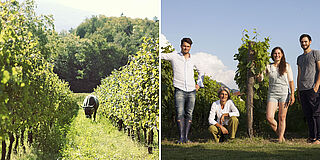
Harvest 2019: »Boom!« and then seven weeks of picking- the longest harvest in our history.
Winter: the winter was quite dry, not too cold. Condition were good for hibernation.
Spring started early, but was interrupted dramatically by snow and cold weather, which continued until May. Skiing conditions were fantastic – the germination terrible. Strong winds in May destroyed 20% of the shoots in the three Granato vineyards. Flowering was problematic.
Summer was not too hot. Rain fall regularly. We had some hail in mid-June, which created damages on Morei and Sgarzon.
Harvest: everything started with an explosion (video will follow). Due to an old valve the tube of our peristaltic pump exploded. Nobody was injured we »just« lost 150 kg of grapes, but our whole courtyard was covered with juice and grapes. Pretty spectacular. What followed was the longest harvest of our history.
Pinot Grigio: the last week of August was wet and hot. This had a bad impact on Pinot Grigio, which is our earliest ripening grape. Botrytis appeared, we were forced to pick in order to not lose brightness. Fermentation was regular, wines are crisp and fragrant.
Manzoni Bianco: because of its thick skin Manzoni was well prepared for the wet end of August. Picking started in the second half of September. Grapes where perfectly ripe, acidity is high. For sure the most convincing white wine this year.
Nosiola: it was a hard year for Nosiola. Very bad flowering, a small crop and lots of humidity in the last weeks before picking made things complicated. Nosiola has a very thin and sensitive skin. We had to make a very strong selection in the vineyard, up to 30% of the grapes fell on the ground. Fermentation was regular, wines are not defined so far.
Teroldego: because of the extreme weather conditions in spring (especially in May) we had a very irregular maturity. There was irregularity in the phenolic maturation in the parcels and even in the single bunches. This forced us to pick everything step by step, waiting patiently for perfect maturity. We passed up to four times through the same vineyards to pick fully ripe grapes. Pergola vineyards had more homogeneity and a better maturity of the tannins, somehow they protected grapes better than the guyot, where grapes were more exposed to harsh conditions. It seems to be a classic vintage: regular long fermentations, good acidity and good equilibrium of tannins.
Let’s wait for the malos to understand more.
Here our news from Marche concerning the 2019 vintage that will be bottled not before July 2020.
The winter was really too warm until February/March. Fortunately in April and May we have cold temperature and a strong humidity (20 days of rain in May). So when the flowering process arrived the equilibrium between temperature and humidity in the soil was OK (Miracle!)
June was with high temperature and rain in good alternating. July and August the same situation. So the harvest was good: good grapes and good weather. So we hope that we will have a good vintage.
We have to thank our old vineyards (average 45/50 years). The old vineyards are more able to manage the actual «historical» passage from the »temperate era« to the new «half tropical era», because they have 6/7 meters of roots able to capture the humidity from the clay, below the limestone soil.
Süden
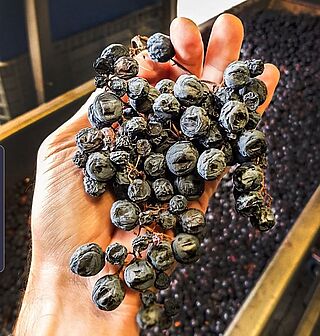
Harvest 2019 officially ended with the vinification of the Montepulciano grapes that had been left to dry at our winery in Roseto (picture attached) that will be an important basis for some of the blends selected by our winemakers. Now we can start to talk about the results.
Thanks to favourable weather conditions, with plenty of rain until the end of May, that enabled the vines to grow with the right amount of water and to create the perfect water reserve, the weather was dry but not too hot for the whole Summer, pleanty of rain until the end of May that allowed the vines to grow without any stress due to a water shortage, the vine has found the best conditions to be able to make its fruits grow better and still today, we have beautiful weather with cool nights and very sunny days, which make the perfect weather conditions for the aromas and the balance of wines.
Quality is 5 star; the grapes arrived at the cellar perfectly healthy and the perfect ripeness, just as the winemakers wished. Harvest and the working were carried out without the stress that the weather conditions usually require when there are rains to avoid, so as to allow us to make wine according to the new protocols that our research and development department has planned to have the highest amount of top quality grapes.
The only negative note was a decrease in the production volume, of about 27 % compared to a standard vintage.
2019 was a very challenging and unique vintage. Due to a cold Spring and a lack of Summer rain the ripening happened late (2 weeks later than usual). We ended to harvest the Primitivo on the very end of September, with the result to have the grapes ripening at lower temperatures. It turned in outstanding freshness and minerality with a wide and intense variety on the fruit notes. A great potential also to perform along the years.
2019 was a very particular year, characterized by a mild winter and a spring with rain and cold (especially May and June), which led to a loss in quantity especially in the Greco area.
In the Falanghina area, the grapes ripened late compared to the average of the last few years, while the production of Fiano was less affected in terms of quantity. Finally, Aglianico, which was favored thanks also to a favorable and well-ventilated climate, especially during the ripening period.
Regarding the quality, the grapes gave great satisfaction both from a polyphenolic ripening and technological point of view, making the wines of great balance immediately. In short, a great vintage is expected.
the 2019 vintage in a scale of 5 points i thinks its a 4,5 score ! It was more fresh than 2018 in Basilicata, the maturity of grape was very long ... with a production less around 20 %.
Probably the 2019 in Basilicata could be rememeber the vintage 2014–2016 and the 2010. For now we are very satisfay of the quality (a little bit less of the decrease of production, but this is the life of the farmer !!)
Klimatrend 2019
Der Jahrgang 2019 war von einem besonderen Klimatrend geprägt, bei dem sich auch im Sommer Hitze und Kälte abwechselten. Im Allgemeinen war die Reifung der Trauben im Vergleich zum Normalzustand verzögert. Die richtigen weinbautechnischen Praktiken haben es uns ermöglicht, die Produktion generell um 10–15% zu steigern und gleichzeitig Trauben von ausgezeichneter Qualität zu sammeln.
Die kühlen Augusttage in Kombination mit einem kurzen, aber intensiven Sommersturm Ende August führten zu einer allgemeinen Verzögerung der Sammlung von etwa ein bis zwei Wochen im Vergleich zu den letzten Jahren. In den Monaten September und Oktober wechselten sich kühle Tage mit vereinzelten Regenschauern mit trockenen, sonnigen und windigen Tagen ab.
Nero d’Avola di Pachino wurde zwischen der zweiten Septemberwoche und der ersten Oktoberwoche geerntet. Der gleiche Nero d’Avola des Kreuzes von Pachino zeichnet sich durch eine besondere und außergewöhnliche Qualität aus. Bestimmt sowohl als Konzentration von Parfums, Zuckern, Säuregehalt, polyphenolischer Reife, Gesundheitszustand als auch als produktive Ausbeute. Die Carricante (Chiaramonte Gulfi) wurde zwischen Ende September und Anfang Oktober geerntet. Nero d’Avola und Frappato (Chiaramonte Gulfi) wurden zwischen der ersten und zweiten Oktoberwoche geerntet. Pinot sull’Etna wurde Mitte September geerntet. Nerello Mascalese am Ätna wurde zwischen der zweiten und dritten Oktoberwoche geerntet.
2019 vintage started in August 21, 6 days before 2018 vintage. Features of this year vintage were favoured by a stable weather, allowing the stability of the grape health, however reduced precipitations during all the vegetative cycle provoked 10 % decrease on our total production, even so quality was excellent.
White and rosé wines show a nice acidity, freshness and outstanding aromatics. Red wines present a lot of fruitiness, with a nice balance and persistence, thanks to the nice phenolic maturity. When we tasted the grapes, before the harvest, we could already perceive that the rind of the berries were slightly thicker and with more skin turgidity that other years.
The result has been wines with clean and clear colour, elegant aromatic intensity and well-integrated tannins.
Overall it was a dry year, with cool temperatures that arrived sooner compared to previous years. The annual total pluviometry was of 490 l/m², very close from the annual average per year 450 l/m². After a very dry winter and regular temperatures, the spring was rainy and cool. Summer was dry with moderate temperatures and some peaks of heat by the last week of June and during the month of July. These conditions provoked a small regression for varieties with short cycle, but all of the varieties finally reached an optimal level of maturation and their sanitary situation was excellent, since meteorological conditions were very positive to avoid the development of fungal infections.
Varieties with short cycle, like Chardonnay and Moscatell of Frontignac, were recollected at their optimal state of maturity. Varieties with half cycle, like Xarel·lo and Merlot, maturation was slower allowing to obtain higher aromatics and healthy skins. Varieties with late cycle, like Parellada, Cabernet Sauvignon and Cabernet Franc, maturation was slowly, with a nice balance between fruitiness and acidity.
During all the period of maturation weather was very stable, which allowed us to harvest the grapes when they reached their optimal state of maturity.
VOILA!
Vintage 2019
After a relatively dry Winter with few snowfalls, the year has been quite dry. We had a rather late flowering, but due to high temperatures during the month of June, it was finally balanced. During August and beginning of September, we had some rains, and moderate temperatures. During the second part of the month of September, the wheather has been very stable, allowing a very good maturation. The yields are quite low, and as a result we wave wines with a certain concentration, but keeping the freshness that characterizes us.
Regarding the wines
Ekam and Ekam Essència will have a creamy and long finish, but always retaining the characteristic nerve of Encus wines. They will be, again, wines with great aging potential.
Regarding wines with a Sauvignon Blanc-Semillón base, we will have a fairly complex and with nerve Taleia. A very important part of this wine (3/4) has been fermented in new oak barrels and we have been very careful not to extract too much wood. Both 2018 and 2019 are vintages with great aging potential.
In the case of Taleia Brisat, this wine will result in a remarcable concentration of skin compounds after almost a month fermenting in one of the external stone vats. As always. Taleia Brisat is elaborated without sulphites, with a certain load of bitterness due to the elaboration process.
For the second consecutive year, we have also prepared a small amount of Taleia Selection from our best parcel. It will be three years before it is ready. Taïka is in a line of finesse and natural acidity as searched, and we will have to wait 6 more years of aging in bottle before we can enjoy it.
We have also produced Majjan, this sweet wine that we keep in barrels for more than 5 years in an oxidative atmosphere. It will have great concentration; one of these wines that can almost be chewed.
In general, red wines wines will be a little more concentrated due to the small size of the grapse because of climatic conditions. All wines have managed to maintain a high degree of acidity that will provide them with a long aging potential.
Pinot Noir will always need a long aging period, both in barrel and in bottle, to maximize its potential. There are no shortcuts in this regard. We will have a 2019 long finish, with cream, fruit and floral aspects.
We have definitely made the best Syrah we have never achieved; with the spicy character that defines our terroir and with a subtle concentration that was our goal.
Regarding Quest 2019, we continue in the line of 2016 vintage (all wine fermentating in stone vats), with more concentrated wines but never forgetting the subtle part and not allowing to much fruit.
Saktih represents our highest-end wines, where we meet the challenge of obtaining a great Merlot, Petit Verdot and Cabernet Franc. Research goes on and we feel that we can offer you – although in small quantities – a subtle and long Merlot without being neither vegetal nor too mature; a Petit Verdot where we have been able to tone their tannins properly and a Cabernet Franc where we could tame the intensity of the precursors of their skin and tannins.
The search around Jhana continues in the Petit Verdot- Merlot line, in the search of rosé wines with long aging potential. It is worth mentioning the experimentation that we are also carrying out with black Grenache.
The great but small harvest of 2019 at Clos Ibai
Climate
Rainfall from the autumn of 2018 until the spring of 2019 was quite below the historical numbers. Frequent storms during the summer of 2019 provided the water to keep the vines in great shape.
As for temperatures, Winter never arrived really save for a few days in January that brought some snow. Spring was also warm despite frosts both in April and in May. In specific places of Rioja Alavesa these late frosts reduced the harvest significantly.
During the month of June there were very pronounced variations in temperatures with episodes of rains and extreme heats until the first days of July, unfavorable conditions for fruit set. In July frequent storms alleviated the water deficit of previous months.
At the end of July and beginning of August the heat returned again. This slowed down the vegetative development. Until its end, the month of August run smoothly, ending the extreme heat and the streak of storms, which allowed the veraison if a bit late for normal standards.
The ripening phase started well, with moderate temperatures during the day, cold nights and no rain. Alerts came again in mid-September when some storms and warm temperatures meant favorable conditions for the development of fungi . Fortunately the rain stopped and the harvest was without scares. It began on September 19, 2019 with the White Garnacha at La Tejera vineyard and we ended on October 3 with the Gracianos.
The Wines
Average yield was around 35 hl/ha and alcohol levels ranged from the 13º for the whites and 13,5º for the reds. Whites are very aromatic and clean with white flowers and precise minerality. Good viscosity in the mouth, with balance and freshness. Still on their lees at the moment and for the next couple of months.
Reds show an intense hue, less poliphenols than previous vintages and very fresh nose and mouth. Mouth freshness is the mark for the vintage. Wines are still aging in oak foudres and concrete tanks, and will remain there for the next six to seven months.
Small but great 2019 wines
A partial fruit settlement, with small bunches, as well as the frosts and small hail in spring meant a small harvest. Very few vineyards used a green harvest in 2019 because the nature did the work for us.
Erntebericht 2019
Das Verhältnis von Qualität und Knappheit wird dieses Jahr noch einmal wiederholt. Die Ernte wurde Mitte Oktober abgeschlossen. Wir berechnen zwischen 35-40% weniger Menge im Vergleich zu einem normalen Jahr aufgrund von Dürre, sind aber sehr zufrieden mit der Frische der Weine, die sich zwischen 14 und 14,5% Alkohol bewegen.
In diesem kontinentalen Klima der Kontraste ernten wir Parzellen durch mehrmalige Traubenverkostungen in der Woche, um die ideale Spannung zwischen Konzentration und Säure zu finden.
Die Weinlese 2019 war außergewöhnlich und hatte ideale Wettereigenschaften für die Herstellung von Qualitätsweinen, die sie zu den besten der letzten Jahrzehnte machen.
2019 ließ die Trauben allmählich reifen und derjenige, der früh erntete, hatte ein gutes Ergebnis und derjenige der es später tat, auch, da man dieses Jahr keine Angst vor Frost haben brauchte.
Das Klima, kühler als andere, hat dem Stil der Weine geholfen, die heute am gefragtesten sind: frischer und fruchtiger, mit höherer, natürlicher Säure.
Der Jahrgang 2019 war kühler als der 2018er und 2017er, mit wenig Niederschlag, ohne Krankheiten, was uns frischere Weine mit mehr Früchten und sauberen Aromen ermöglicht. Zusammenfassend eine großartige Ernte.
Our harvest 2019 was excellent due to the wet spring and dry summer that we had (perfect conditions and ideal combination), but we had suddenly at the end of Mai and early June an unexpected heat which burned a good part of our grapes.
Therefore Martin Freixa vintage 2019 will be very short in production.
Zu allen Weinen
General summary of 2019
Climatologicly it was a dry and warm year, this made the ideal sanitary conditions but also very limited productive yields, despite of everything, one of the best vintages of the decade in terms of quality.
The 2019 started with the threat of an early sprouting after a warm winter ending. February and March were warmer bringing the the first sprouts.
The beginning of spring was the inflection point, starting very cold in the first two weeks, this slowed down the fast growing of the bloom and reduced the risk of frost. Anyway May and june were fresh months, even cold and this brought a slower development of the vines. This gave the carachter to this vintage with a very prolonged flowering.
The start of summer with extreme temperatures at the ending of june left one of the biggest heat waves since 2003. July was also hot but not that extreme, anyway globaly was the hottest month since there are records. During this period, the end of flowering and the start of ripening, the berries size was small and since the first samplings with green berries were anouncing reduction of yield.
The first weight analisis of the berries were also anouncing a reduction of production comparing to previous years. At this point, the vegetation
was already very balanced, despite the drought there were few rains in the exact moments for the vineyard. In august the temperature was fresher and dry giving expectations of an historic vintage.
September the final stage of the cicle begun quit fresh but the end of the month was warm, the hot and the size of the cluster plus the good ventilation had the result of a early harvest. The ripening was homegeneous and there was a good climate condition for the harvest all the red grapes.
The harvest of 2019 finished with 20–25% less comparing to the previous year.
End point to our 2019 harvest. The harvest season started on 9 September in the vineyards of Lagar de Cervera, Rías Baixas, and ended on Wednesday 16 October in the Áster vineyards in Ribera del Duero. They were six weeks during which a great team of more than 150 people worked hard both at the vineyard and at our four wineries, performing essential harvest tasks whose results confirm good expectations.
Of particular note was the high quality of the Torre de Oña grapes, leading the Head Winemaker Julio Sáenz to state that «we are quite possibly looking at one of the best crops ever» for our winery in Rioja Alavesa. This follows on the laboratory tests and sensory tastings of the first musts, which prove «very well-balanced, with high colour intensity, very good acidity, great freshness and outstanding aromatic intensity, with that strong fruit expression that we require in our Rioja Alavesa wines.»
Meanwhile, at La Rioja Alta, S. A., the initial balance is also positive despite the difficult weather that plagued our vineyards throughout the year. Constant work on the estates, harvesting grapes in small boxes and optical selection have allowed us to achieve some particularly good wines with high colour intensity; very suitable for barrel aging. The only issue is the alcoholic strength, which was significantly higher than that of previous vintages.
At Áster, we were very patient and waited until a very good ripening balance was reached in the Tinta del País grapes. This meant getting musts with a high colour intensity and firm, friendly tannins that make us quite optimistic about their evolution. In this case, alcoholic strength has also been somewhat higher than in previous crops.
Finally, in our Galician winery, Lagar de Cervera, the wines have already concluded their fermentations without incident. We are very happy with the quality achieved, although there was a significant drop in production, as in the rest of the Rías Baixas, which for us could be as low as 40 % below last year’s figures.
The 2018/2019 Viticultural Year was characterized by large fluctuations in temperature and lower than normal annual precipitation, considering a dry year. Climatic conditions led, in an initial phase, to a slight advance of the vegetative cycle in relation to the average of the last 5 years, an advance that has been attenuating throughout the cycle. Despite the occurrence of high rainfall during the month of April, the climatic evolution recorded later, contributed to an excellent phytosanitary quality of the bunches at harvest.
Despite the occurrence of punctual precipitation in the harvest period, with a positive impact on the evolution of ripening, the good phytosanitary quality of the bunches allowed to wait for the good ripeness of the grape. The harvest provided high quality musts, lovely pure fruit, good balanced, great acidity and medium levels of alcohol and a good level of phenolic compounds.
The Viticulture Year of 2018/2019 was characterized by large fluctuations in temperature values and lower than normal annual precipitation, considering a dry year. Weather conditions led, at an early stage, to a slight advance in the vegetative cycle in relation to the average of the last 5 years, this advance has been attenuating throughout the cycle. Despite the occurrence of high precipitation during April, climate developments recorded later contributed to an excellent phytosanitary quality of bunches to harvest.
The harvest began, around of the second week of September, slightly later (about 5 days), when compared to the average date of the last five years, and has been prolonged slightly until later, as a result of the good weather conditions recorded in that period. Despite the occurrence of punctual precipitation in the harvest period, with a positive impact on the evolution of maturation, the good phytosanitary quality of the bunches allowed us to wait for the good maturation of the grape. The harvest provided high quality musts, usually with higher acidity, lower alcohol and a good level of phenolic compounds.
We are hopeful of having great quality wines, whites and reds, in 2019 vintage.
About 2019, it’s more fresh than 2018 with less 3 degrees in Max Temp and less 2 degrees in Min Temp, during maturation. However we had less 25% of water, so it has been a very balanced the maturation. The aroma is a little more fresher, as lemon and lime, with less ripen fruit in the mouth comparing with 2018.
About the wield we had less 27% because of the cold temperatures during flowering, less than 10 degrees and the Alvarinho grape is very sensible to rain and low temperatures during flowering. So in resume, is a less production year with more fresh style.
2019 was a very good year, and has resulted in wines that I would call classic for Northern California, on the prettier rather than heavier side. We did have a very late Spring season, with rain extending well into April and delaying the flowering. However we were then fortunate that we had no early rains, with a warm and dry October. This gave us actually an slightly extended ripening period, which I always associate with elegant, long-lived vintages.
You will of course have heard of another bad fire in Sonoma County, and this was significant for many of the people I work with. Several winemaking families had to evacuate from homes and wineries, even though most fruit was harvested and safely in tank before these events. Everyone is critically aware of the dangers of smoke-tainted fruit, and of course where those wines exist they are being kept isolated and will not be in the bottles of the premium growers we work with. In the Napa Valley, where I live, we were fortunate to have no smoke influence from this northern fire, as the winds pushed it directly out to the Pacific Ocean.
Michael Havens from
California American Terroirs
Vintage Notes / Forman & Chateau La Grande Roche Cabernets:
Both 2018 and 2019 were quite a phenomenon in that they were bountiful in quantity and superb in quality. The fruit benefited from mild fall ripening temperatures and thus both vintages were able to acquire full flavor and phenolic strength. Cabernet Sauvignon, Merlot, Cabernet Franc & Petite Verdot all flourished. Quite an amazing vintage duo. These will be quite concentrated wines with some very authoritative statements.
We are very fortunate on the north coast of California to have two outstanding vintages in a row for Pinot Noir and Chardonnay. Like 2018, the 2019 wines show excellent concentration and aromatic expression. The spring was very wet and vine growth was slow. However, we had a beautiful summer with no exceptional heat waves and harvest spanned most of September without any major issues.
We are very excited by the potential for the vintage.
As McManis Family Vineyards is located in the Northern Interior Valley and the majority of it’s vineyards (60%) are in Lodi, we are typically faced with fairly consistent growing periods and harvests. This area typically is south of major storm events that occur in the North Coast. As a result, our harvests and growing periods are very predictable with little variation. 2019 was no different. We had a very large crop in 2018 and the 2019 was also above average in size, but not nearly the amounts of 2018.
2019 Vintage at Monte Bello Winery
Following the dry winter of 2018, the heavy rains of 2019 were welcome. A moderately strong El Nino formed in the eastern Pacific, which intensified storms and directed their energy at California. Monte Bello received sixty-five inches of rain for the season, twice our average amount. It rained often, but not torrentially as the weather systems moved through. It allowed for good absorption into the subsoil avoiding erosion while replenishing underground water reserves. Once spring arrived, there was explosive growth of grass and cover-crop that helped with drawing excess water out of the ground. This was followed by frequent mowing which prevented nutrients being pulled away from the vines. Our Sonoma County vineyards received a larger amount of rain than did Monte Bello. The ground was saturated with water through late spring. Having great drainage in these vineyards was essential for inducing water stress later in the growing season.
Once summer arrived, it brought several lengthy heat waves between June and July. This accelerated the growing season and energized the vines into extending their shoots and filling out canopies, growing inches by the day. For most vineyards, flowering occurred during calm weather. Clusters were full and abundant. The merlot parcels at Monte Bello were the only ones that got caught by bad weather during bloom. Their clusters had a lot of shatter resulting in great concentration but unusually low yields. Throughout August and September, despite bursts of heat, cold foggy weather slowed ripening. Our first pick was done on August 23rd, bringing in the old vine carignan from the Evangleho vineyard in Contra Costa County. Dusi Ranch zinfandel from Paso Robles followed on September 2nd. Geyserville took much longer to ripen with the first block not coming off until September 16th. The rest of Geyserville trickled in, with most of it brought in at the end of September. The last three parcels were petite sirah harvested on October 8th.
Monte Bello’s chardonnay ripened later than normal, while the white rhone vines in the Adelaida District ripened right on time (middle-to-late September.) During that time, there was a surge of white grapes coming into the winery and requiring the presses. It was at the same time that many red fermentors needed to be drained and pressed. With the pace of this harvest, and yields being larger than expected, quick turnover of fermentors was necessary. At the peak of harvest there were forty red tanks filled and fermenting at once – the »critical mass« moment of harvest. Our small fermentors achieve greater extraction from the skins during fermentation and also allows us to separate vineyard parcels as they are harvested. This approach gives more options during assemblage so we can be more selective with the lots chosen. For the 2019 vintage at Monte Bello we fermented 172 red and 19 white wine lots. Assemblages have already been done for most of the zinfandels. Chardonnay, white rhone varietals, and Monte Bello components will be tasted and assembled throughout the first half of 2020. Though young, the zinfandels are delicious and more on the elegant side. Chardonnay and white rhones are still fermenting, but promise to be of some of the finest quality I have ever seen; they are truly amazing and it will be very exciting to see how they come together after malolactics finish this coming spring.
Monte Bello’s bordeaux grapes were slow to ferment but produced outstanding quality. Our only wish would have been for more merlot, which is the shining star of the vintage. There are so many excellent lots to choose from to make the 2019 Monte Bello. Merlot, cabernet and petit verdot, should come together beautifully at assemblage and produce a good number of cases. We had to pull out the cabernet franc parcel at Rousten, so for now we only have our oldest block to consider adding. It was, as in the past several years, co-fermented with the surrounding old vine merlot and cabernet sauvignon. This may be the most successful vintage of having done this co-fermentation. The wine is quite deep and sensuous. Currently, in the cellar the wines are quickly finishing malolactics and starting to settle down. The first assemblage will happen in early February. There is always great anticipation among the winemaking and vineyard teams for this tasting. It is the culmination of all our hard work of farming the vineyard and extraordinary care in the winery.
The weather before the beginning of the harvest was a rollercoaster showing extreme temperatures, going from days with 5 ºC in Gualtallary to other days with 38 ºC in Lujan de Cuyo. We carried out a very strict control on the ripeness of the grapes, to determine the exact date in which they would be ready for harvest, and specially to avoid an excessive sugar level.
Therefore we were able to follow our early harvest philosophy and began picking up our Lujan de Cuyo Malbec on the 19th February and the Bonarda on the 26th February. The harvest on the Uco Valley began on the same 26th, and we are still picking up grapes! The ants keep working non-stop!
Due to frost damage on our lower lying areas in early spring of 2018, we lost about 10 % of our Sauvignon crop. In our attempt to combat the frost, we rented a helicopter to fly over the lower areas to stir up the colder air and disrupt the inversion layer. We rented the helicopter for 3 nights, unfortunately the worst damage was on the 4th night, when we least expected it. The week preceding this damaging frost was unseasonably warm with a daytime high of 40 °C the day before, and -1 °C that very night. So not only did we incur the damage, but we also lost the money it cost to rent the helicopter. The first of our wind turbines for frost prevention arrived in winter 2019. The unusually warm weather and the frost that followed was in the middle of the critical flowering stage, so we had a smaller crop across the board as a result of this. Despite this, the fruit was healthy and the wines they made were pure with great acidity and wonderfully concentrated flavour.
The severe drought and resulting water shortage in the Cape was very challenging in certain areas, such as Olifantsriver, the Swartland, and some farmers in our valley suffering severely in 2019 and even now in 2020 still. While the rains in winter did come, the vines were still showing the effect of the 2018 drought in the 2019 vintage.
The 2019 vintage is now through its Malo and is lying in barrel awaiting racking to final cuvees. The season was fairly unremarkable, a threat of early frosts and a cool spring gave us modest flowering, The season stayed cool, wet, and unsettled until March when warm and settled weather brought a start to harvest on 29th March. The whole harvest waqs completed in 12 days, resulting in a crop around 20 % down on average.
These cool, unsettled years are when we make our best wines (nobody seems to understand why!). 2019 Pinots are a benchmark vintage. We always prefer our recent vintages when vine age shows to the best, but this is a year when we expect to surpass all those that have gone before. Harmony is the key character. There is concentration, and balance, but there is an over-riding feeling of perfect contentment in each wine.
The wines may be delivered a little later than normally as we will not bottle each cuvee until we are sure the elevage has been sufficient.
Chardonnays and Rieslings are also exhibiting exceptional character.
